#in part because of romans being conquerors but still
Explore tagged Tumblr posts
Text
I just saw someone say that Greek Mythology is about Intergenerational Trauma and Abuse. and
I kinda want to scream.
#greek mythology#yes#it's a valid way to use mythology to tell a story#but the greek myths aren't one thing#they are everything at the same time#About desire#about the relationship between Man and nature#about mortals and the divine#Trying to understand the unknown and give meaning to the chaos of the world#about human flaws#and about human greatness#And to have a good laugh at the misfortune of some fools#it's a drama and a sitcom at the same time#it's a clusterfuck of barely coherent random bullshit stappled together with duct tape#and it's some of the most universal stories#in part because of romans being conquerors but still#to try to define it as a single thing because you like that version of that thing is foolish#myth#myths
7 notes
·
View notes
Note
So does Minase joins Meteo of being a writer that picked a figure from regions that aren’t as used as much in TM with the Trung sisters belonging to him?
This one is just a self-answering yes-no question, so I'll instead use it as a platform for the Minase thoughts I've been having since the wombo-combo of the new mats, the anniversary interview, and the Dubai event. It's probably what the anon wanted out of it anyway.
My inner ramblings start from something Nasu said in last year's interview and made a point to reiterate this year.

Ordeal Calls are meant to be each writer's best and most emblematic piece. Their artistic identity taken to its peak. That's something I believe Sakurai accomplished and Minase didn't. That obviously raises one question: what would a real Minase masterpiece look like?
By the Ordeal Call's premise, it would still need to be something that gave the supplementary information we were missing about the Alterego class, but let's ignore that angle and focus only on the goal of expressing Minase's personality in the best way possible.
What works with Minase and what doesn't? Compare his worst and best pieces. Agartha sucks because it focuses on his opinions about women and those are categorically rancid. Yuga Kshetra succeeds because it focuses on his opinions about ableism, which are far more poignant and agreeable. Minase has enough care about the subject to ensure that the plot is a series of arrangements where the characters triumph not despite their so-called flaws but specifically because of them.
So an ideal Minase Ordeal would focus on a different subject that Minase recurrently displays passionate, empathetic, and agreeable opinions about. So what can we find in his roster of character? Minase made Servant versions:
Zenobia, whose historical significance is entirely about resisting Roman colonization, although she failed. Minase portrays as someone who literally wears her failure and tries to conduct herself with dignity regardless to prove the point that the Roman conquerors couldn't truly defeat her Palmyra spirit. I think this one is a bust execution-wise, but it's significant that the idea is there.
Lakshmi Bai, whose historical significance is entirely about resisting English colonization. Minase portrays her as someone who can't help but disdain the innocent English civilian Holmes and acknowledges the irrationality of it, but the entire surrounding cast including Holmes himself assure her that she is entitled to her feeling because colonization is that gruesome and traumatic of a process.
The Trung sisters, whose historical significance comes not exactly from resisting colonization, but from leading an independence war, which is similar enough in spirit.
Columbus, whose historical significance comes from being a colonizer. I don't need to tell you how Minase chose to portray him.
With Fate/ drawing its action cast from history books, it's inevitable that we get a decent amount of characters whose bulk of their offscreen backstory was spent conquering, slaughtering, and assimilating other cultures. Some certified colonizers, like Richard and Takeru, are very self-critical about it. On the opposite end of the spectrum, we have Iskandar, who gets flak from Faker and Ptolemy for his stupid decisions toward the Diadochi, but the journey of conquest and domination gets framed as the fun adventure no one is critical of. Either way, none of other characters not written by Minase get irredeemable treatment that Columbus gets.
The franchise's most prominent colonizer is, of course, Arthur(ia) Pendragon. Both versions are defined by the regret that comes with ultimately failing their kingdom, but their failings are never credited to the notion that violently conquering the British tribes and unifying the isles is an inherently bad thing. That's the image of greater good they fought for, and that part remains unchallenged. The closest Nasu got to criticizing Arthuria for being a colonizer is by showing the Round Table's brutal treatment of the Arabs in the Sixth Singularity. I'm mentioned this specially because this is Percival's first reaction to eating a mixed breakfast buffet in the current Minase-written Dubai event:


Minase's Percival is strongly defined by his respectful interest in foreign cultures and, fittingly enough for a knight who opposed the Lion King, he's maybe the first character to directly criticize Arthuria on her disregard for the traditions she trampled in the unification of Britain. That's a thing I'd appreciate more of and can only imagine Minase daring to touch on.
45 notes
·
View notes
Note
I've been playing with the idea of part of WindClan territory being on a Pleistocene bonebed and someone finding a smilodon skull and thinking it was from one of their gods/a skull from a mountain settler. Maybe they think it's the skull of Shattered Ice because it was found near tunnels (their oral history traditions didn't preserve that he eventually joined RiverClan) It's unrealistic and would need a lot of geography fuckery, but it's a fun idea
Not actually as far fetched as you think, the only thing wrong here is the mention of a smilodon specifically. That's an American animal; you're more likely to find the Eurasian Cave Lion or a Scimitar Cat where I put BB.
Or even just, like, a normal European lion. England did very much have real lions that went extinct, and then the Romans brought MORE lions because they liked watching them fight.
Which is also a possibility by the way. The Romans were all up in this area, building walls and arenas and roads and other Roman things. The Roman Empire is ECOLOGICALLY VALID lmao
Like I'm deadass. They still have structures from Roman settlement. There's a funny story about William the Conqueror being super disappointed that this one Great Wall was less cool in person than his travel guide or whatever told him, and he got so mad he burnt the city down about it.
(Normal tourist reaction)
I want to throw some ruins into WindClan, too. So if not lions, then they probably could bump into human skeletons, or various bones of livestock. For some reason I want Breezepelt to find a skull and I don't even know why.
51 notes
·
View notes
Text
In the far past, Kryptonians were a race that was enslaved and genetically modified by the more technologically advanced interplanetary invaders, the Coluans.
The Kryptonians fought and won their freedom and planet back. The tech left behind by the Coluans was used and improved on by the Kryptonians.
In one portion of their rich history, the Kryptonians themselves would go on to be planetary conquerors and settlers akin to Earth’s Roman empire.
In order to have a firm hold of their planet, Kryptonians introduced a mutagen into their DNA that would allow a member of their species to be able to reproduce with an alien sapient species.
The method by which to activate it would be for the Kryptonian to have had enough intercourse with a being that induces feelings akin to love (lust, respect, protectiveness, etc.).
Thus such people’s as the Daxamites came into being.
Later on, the Krypton’s leading government would become replaced by the Science guild. Eventually Krypton’s colonies would become independent civilizations.
Krypton eventually would become more and more closed off.
The mutagen, however, would continue to exist among the Kryptonian populace and at times be activated if only among the lower classes where traditional reproduction still continues as opposed to the Birthing Matrix among the upper echelons.
Lara Lor-Van, whose natural birth caused a scandal within the traditional House of Van, knew of the ancient mutagen that is dormant among Kryptonians.
Not wanting her son to be forever alone on a strange planet, she made sure to activate the gene so that Kal El would be able to father children with the Earthling he chooses.
More than a Earth decade later, a young Clark Kent had left Smallville to travel the world. In part, trying to find purpose again after losing his lover and best friend, Lex, to amnesia caused by an experiment on Krypton tech gone wrong. In another, fleeing from Lex’s father Lionel who was powerful enough to blackmail and threaten Clark to stay away from Lex.
In addition to his heart pain, he was losing his powers and was becoming weaker every day.
He had to rely more and more on Krypto, a dog who was mutated by the green meteorite of Smallville, & Lori Lemaris, a friend he made at the college he used to secretly visit Lex at.
It was only after he was examined by another friend (Immortal Man) he made on his travels that he found out what was happening.
Apparently, pregnant male Kryptonians would lose muscle mass and become more aggressive if they felt threatened. Instead of their stomach distending, their organs would rearrange for the growing baby. This was so that male Kryptonians would be unencumbered if they needed to flee from danger that their mate/family/allies would deal with. It would also discourage the pregnant male from engaging in stressful activities and focus on his well-being.
After an intense labor that eventually lead to Clark just cutting himself open, Conner Julian Kent was born. (Julian was from Lionel’s estranged brother Jules, a lawyer living in Smallville whom both boys loved and respected).
From then on, Clark swore to keep his child safe and to be a strong person Conner could look to as an example.
For that reason, Clark didn’t dare go back home until after Lionel died. In the meantime, he’d learn everything he could: about the world, humanity, & his and Conner’s heritage.
When he could finally return home, Clark decided to take the job offer he got from an editor at the Daily Planet. Because to do the most good, Metropolis, Delaware was the best place. Plus it was the city closest to Smallville aka “little Kansas”.
From there, he would be confronted by the so called philanthropist and man of tomorrow, Lex Luthor.
Having already grieved, Clark saw Luthor for what he really was: an immoral Machiavellian narcissist criminal who hated and looked down on humanity. Who would do anything and use anyone to get what he wanted: being the top of the food chain.
Clark was determined not only to stop him, but to never let him near Conner.
This began a war between a “meddling alien who is a threat to human progress” & “a man who could have done so much good if only he’d choose to do so”.
#clex#my work#story ideas#please writers#please write this#mpreg#superman#clark kent#kal el#krypton#kryptonian#kryptonian history#lara lor van#lex luthor#conner kent#lionel luthor#smallville#kon el#kon el kent#krypto#lori lemaris#superboy#metropolis#silver age comics#pseudoscience#daily planet#story prompt
49 notes
·
View notes
Note
Two of the biggest problems with HOTD's costuming is that it's simultaneously *too* similar to GOT, despite being centuries ago, and all over the place. Clothing would have been similar within a time period but class and cultural differences would also influence style. Both Alicients had costumes that doesn't indicate a cohesive Hightower look beyond green. With ROP, the costumes had rhyme and reason because the designer designed for each culture and actually worked on the Hobbit movies too.
Yeah, like, one thing Michelle Clapton did very well in GoT was making the different regions in Westeros and Essos look distinctive, and stay coherent about it. I'd argue the quality went down in the later seasons, but the basic ideas and concepts were there throughout, and for the most part, they had decent wigs! And keep in mind season 1 of GoT didn't have that big of a budget and it still looked better than HotD!
Like, I can see a few Tudor references here and there (Alicent has a veil that looks like a French hood from time to time, Rhaenyra has a gown that looks like an Elizabethan era dress with the white collar and all), but I don't really get why it's "Tudor-inspired", given the ASOIAF universe is basically an AU of medieval England (Aegon I is William the Conqueror, Rhaenyra is Empress Matilda, ASOIAF itself is the Wars of the Roses). The styling is just not different enough for me to really notice how it changed from one period to another - and you don't need to make it more simplistic, just give me something. Hell, they could have gotten away with a Roman-inspired look where Rhaenyra, Rhaenys and Laena wear hairstyles like this:
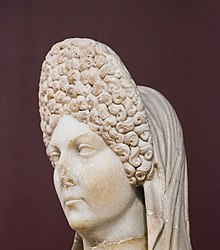
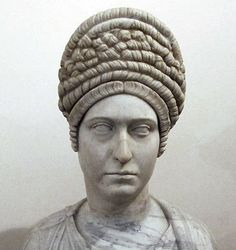
And if you want Alicent to be a Livia Drusilla type where she presents herself as a "traditional woman" who doesn't have time to look frivolous, you could go with something like this:
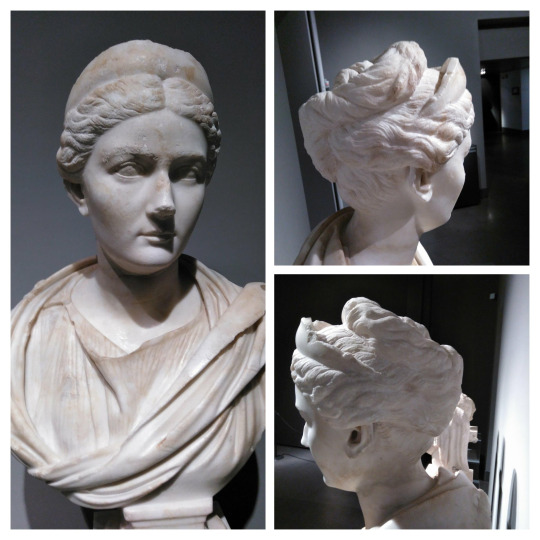
Seriously, have fun with it! You could also have the Hightowers with the traditional Roman inspired fashion, and have the Targaryens decked out like Byzantine emperors. Like, you'd THINK the fall of the Targaryen dynasty would lead to huge changes in dress, because the Targs would probably opt for Valyrian fashions that the court would have tried to emulate, and then Robert Baratheon basically throws all of that out of the window and the "fashionable" style is now pretty much dictated by Cersei, since she's the queen.
Kate Hawley meanwhile is the costume designer for RoP, and she did design for opera, AND IT SHOWS. She also did the costumes for Crimson Peak - which is probably one of the best I've ever seen in a period drama, and I'm not even kidding. Take for instance Edith and Lucille - Edith is a rich heiress, so she wears silhouettes that were in vogue at the time and has a Gibson Girl look to her:

And even then, even if the silhouette is pretty much prefectly accurate, she's still able to have fun with it! The fabrics used here weren't necesarily used in the Edwardian era, but the idea was to use some that looked similar to butterfly wings, and it works!
Lucille, meanwhile, wears gowns with a silhouette that was in vogue in the 1870s-1880s, with the bustles and all, but not anymore. It looks out of place during the evening party where she plays the piano for everyone, and her clothing is one of the things that awakens Edith's father's suspicion. It would be one thing if she was an old lady (since they tended to wear dresses that had gone of fashion 20-30 years ago, hence why in P&P 2005, you'll see Mrs. Bennet wearing a rococo dress at the Netherfield ball), but Lucille isn't that old.


And the thing is, the Sharpes are low on money, but fashion was meant to be sustainable at that time and Lucille could easily adjust her dresses to have a more fashionable silhouette, and use the removed fabric for other stuff, instead of having to buy something new. She chooses not to, and it's deliberate, probably because the dresses she wears belonged to her mother.
See? That's thought and care right there.
Meanwhile, see this dress? Alicent Hightower wishes she looked that good:
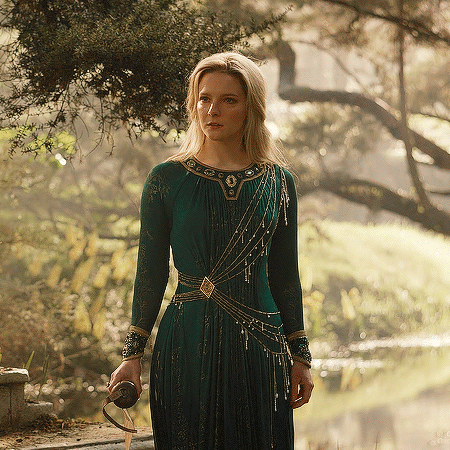
And the thing is, with all the pleating, the belt thingy she has, it would be so easy to mess up and have her dress look frumpy. The belt is perfectly adjusted and provides the watery effect it's supposed to have, the pleating is nice, and the dress actually looks like it was made specifically for her. Which makes sense, because Galadriel is a Noldo princess and she'd absolutely have her clothing tailor-made, and have it be from the best Elven seamstresses you can find. It looks so simple at first, but the more you look at it, the more you see all the little details it has. And they didn't mess up her hair, either (and anyone who's read the Silmarillon knows Galadriel's hair is important!). They used Morfydd Clark's natural hair, added extensions, made sure there were golden and silver undertones, and voilà.
And the costume department did their homework when it comes to the design - they took inspiration from pre-Raphaelite artists when it comes to the Elves, and also a little bit for Númenor as well - which makes sense given the connection they have to Elves, but they still look distinctive, with plenty of little details referring to Elros' origins here and there. Bronwyn has a dress that looks different from the other villagers, yes, but given she's a healer, she'd probably know how to dye her clothes and would dress more lightly due to spending a lot of time outside looking for herbs. The Dwarves look VERY different from the rest, and Disa has some great outfits, but you can tell their clothes became the way they were given they spend more of their time underground. The Harfoots seem to be wearing stuff they found while travelling, since they don't seem to have equipment to weave cloth and they often seem like they're wearing stuff that's too big for them. And I'm only scratching the surface here.
#hotd critical#rings of power#costume nerd tag#costumes#every time i see someone on the internet saying the costumes on hotd were better than in rop i lose a year of my life#just say you looked at the elven pompadours and not much else and go#“BUT BRONWYN IS SLEEVELESS” yeah so? women's arms excite you#mkay#how you got through hotd without a heart attack is beyond me but okay
67 notes
·
View notes
Text

——————
It *is* a 3000-year-old embroidery art, but it being 3000 years old and Jews having lived in that land 3000 years ago (and some Jews living there continuously over 3000 years) does not mean the embroidery art isn’t a part of the Palestinian people’s cultural inheritance. Also, something originating in an areas where Jews live/lived does not inherently make it Jewish. Location is not the sole determiner of whether a group “owns” a practice, otherwise I could claim the practices of Irish Travelers because they originated in the same location as where my ancestors were born and lived under Irish governance.
Additionally, something can be practiced by more than one group of people. Ancient Jews practicing a form of needlework does not negate the fact it is a part of Palestinian culture. It’s not an either-or situation. Something having Jewish practitioners does not mean it can’t be culturally significant to another ethnic/national group. People in a region can and will have shared practices. This would be like saying hummus is *exclusively* Jewish simply because some Jews eat hummus (as opposed to saying that hummus is a common dish in the SWANA region and is a staple of many SWANA Jewish households).
Also, most Palestinians share a strong genetic link to the ancient Canaanites. So, Palestinians *have* been living in Palestine for 3000+ years and *are* among the modern descendants of the ancient people who lived there. Them being Arab or having a diverse history does not mean they have no claim to self-determination in the region. And while Palestinians do have genetic links to ancient Canaanites as well as the ancient Samaritans, slaves from ancient sub-Saharan Africa, *and* the Arab tribes from the Arabian Peninsula, the Palestinian people’s Arab identity primarily comes from a linguistic & cultural connection.
(I’d hate to see what the OP would have to say about Jews from the SWANA region— what do you think they spoke, what cultural practices do you think they enjoyed, and what traditions do you think they observed before being expelled from Yemen, Syria, or Egypt? You think they were eating German Carp and primarily speaking Dutch? Have you considered that they know and have spoken Arabic and danced Dabke? Like… maybe, maybe an Arab linguistic and cultural connection doesn’t invalidate a people’s sovereignty, national identity, or right to safety and self-determination? Or are you also going to argue that mizrachim Jews are Arab invaders and conquerors because they share linguistic and cultural and genetic connections to non-Jewish Syrians and Yemenis and, once long ago, those tribes from that Peninsula?)
The Levant has been occupied by several empires over the millennia and has undergone a lot of political, cultural, and demographic change, whether from wars, immigration, or occupation. So, the region has experienced great change and a lot of diversity throughout the ages. The people who have lived in this region have thus formed their own unique national, ethnic, and cultural identity. Diversity in the region or among a people does not negate someone’s history in a region or their identity as a people. Nor does it negate the fact that they will have their own unique or specific cultural practices. Jewish people, for example, are still a people with their own unique cultural traditions despite having great diversity.
Palestinian families have been living under various different occupations for thousands of years, including Roman, Byzantine, Ottoman, English, and Israeli. Living under occupation does not negate that Palestinian people exist and have a long history in Palestine. Living under occupation for millennia also does not invalidate a people’s cultural inheritance, their connection to a land, their national identity, or the uniqueness of their cultural and national identity. Jewish people, fore example, still have their own unique cultural and ethnic identity, connection as a people, local and cultural traditions, and a spiritual connection to the Levant despite also experiencing several millennia of ethnic cleansing, genocide, forced displacement, and occupation.
Tatreez is a form of traditional Palestinian embroidery recognized by UNESCO as an important intangible cultural heritage. Tatreez is the romanized version of an Arabic word, تَطْرِيز, meaning embroidery or needlework, so it is quite literally not Hebrew, linguistically. Written accounts of tatreez date back as far as the 1700s, long before English and Israeli occupation, and long *after* they were first occupied by an Arabic-speaking group in the 7th century. Each village in occupied Palestine had/have their own tatreez patterns, with unique designs telling stories about the local people. It has been used as a means of preserving Palestinian culture and history, offering a people who have also been victim of ethnic cleansing and genocide over several millennia solace and connection. They are stitching their national and ethnic identity. Tatreez has become an important symbol of resistance, women’s economic autonomy, and the diaspora’s connection to their ancestral homeland from which they and their family were displaced. Due to ongoing ethnic cleansing, genocide, and occupation, tatreez is endangered.
Read more about tatreez below:
4 notes
·
View notes
Text
Just something interesting about the differences between TOTK Ganondorf stealing the gemstone and OOT Ganonforf stealing the triforce, because people have been saying it's the same thing just in a different shape...
Except what's interesting about the Triforce is that Ganondorf doesn't "steal" it, exactly, he earns it. Because lets face it the Three Goddesses are kinda amoral, they grant gifts to those they deem worthy but not out of a desire to "save" Hyrule. Ganondorf gets the Triforce of Power because Din chooses him by how far he goes to acheive it, while Nayru chooses Zelda and Farore chooses Link. But the goddesses won't stop the other pieces from being "taken" if one goes as far to reunite them and gain all three, as what happens in Wind Waker. All three timelines of this Ganondorf keep their Triforce, even after having been defeated or sealed. It's only lost either when Din chooses to take it back, possibly because she doesn't deem Ganondorf worthy anymore, in Twilight Princess, or Link is able to take it like in A Link to the Past or the first Zelda (how Ganondorf got it back between those Idk, I can't deal with the timeline anymore).
Anyway, compare that Sonia's stone which he takes after murdering her, while it does greatly empower him, it's not something that's been divinely gifted like the Triforce. It's actually rather fragile in comparison. The Triforce embeds itself in your soul, as it were, hence why even when the sages tried to execute him in TP the power was still gifted to him by Din to escape. The gemstone however can be shattered by a weapon or just handed at random to any person who touches it. It's much more your typical fantasy mcguffen where it's like "finders keepers". The goddesses no longer play a part in what seemed to be a long game.
In fact there doesn't seem to be any reference to the three goddesses in these new games, only Hylia. And yet we also know these are supposed to take place at the end of the timeline, so far after all the other games.
The only signs of the Triforce we see are on some markings, including the Zonai clothes. So my theory is the Zonai were able to harness the magic of the Triforce and the old gods into their technology, but the goddesses don't really care about those. Part of me suspects the goddesses stopped caring about Hyrule much after Wind Waker, as Ganondorf says they abandoned them (still the creepiest moment from him, ngl).
"But Rauru was the first King of Hyrule!" Uh, yeah...I don't buy that. Not because I think Skyward Link and Zelda founded Hyrule, that's never said, they could have just lived in a small settlement down on the land, nothing big enough to be a kingdom. But also I just feel like it's the Zonai trying to rewrite history in their favour.
For example, if you were to ask someone in England who our first King was, most folk would say William the Conqueror. And this is what most of us were taught in school and that prior to him we were just warring minor kingdoms and at some point the Romans turned up for a bit. But anyone who's watched the Last Kingdom knows it was Alfred the Great who was first called "King of the Anglo Saxons" as opposed to the areas under Scandinavian rule, so some credit him with being the first "King of the English" to some degree, but it was his grandson Aethelstan who would rule over all the land that would become England - and this is all about a century before Will One comes anywhere near the country. But then he takes over and claims those old kings didn't count, he wipes the slate clean despite the land he's King of having existed for centuries, and I suspect Rauru did similar. Don't get me wrong, I think Rauru is a good guy, but Ganondorf rightly calls him out for his arrogance and being a conquerer, and I think a huge part of Ganondorf launching his attacks was a fear of having the Gerudo, his people, submit to another King like the other races did.
Another point to add is that Ganondorf comments about Rauru marrying a "Hyrulean" woman, implying the land was known as Hyrule before Rauru took power. We know he also got the other races to bow to him as well. We don't know what this Hyrule was before Rauru, maybe a scatter of settlements like early England or maybe it was the newly formed land Link and Tetra find after Wind Waker, who knows. This is why I think even the events we are shown in the tears are events still happening at the end of the timeline and the next 10,000 years are all part of this new era unique to these new open world games, as opposed to a reiminagining of the events of Ocarina of Time. Because for me there's too many differences for them to be the same event, the lack of the Triforce being the main one. This is instead more of Hyrule repeating the events Demise cursed upon them back at the beginning of it all. Or it could be his curse coming to full fruition after tens of thousands of years, as Ganondorf physically resembles him by the end more than ever before. In short, this Ganondorf is not the same as in OOT, TP or Wind Waker.
I'm curious to see if the Triforce will ever make a real return in the series, but I also feel like Nintendo are enjoying not feeling obliged to use it in every Zelda (lets be honest it was a little forced and underwritten in SS).
22 notes
·
View notes
Text
youtube
Brigitte Empire! A writer for the Daily Telegraph and prospective British ex-pat who could use your clicks and attention - and money, if you can afford it! Today, she's unpacking a little of the British Empire's colonial legacy.
And while I have your attention, would you like to talk about why mere gayness is seen as such a threat to colonial power structures?
You exist on Tumblr, you've seen this:

...or maybe this version:

Gayness has been criminalized for so long it's gone memetic, and it's a badge of honour. Alright, you're gonna make my very existence illegal, I'm gonna do whatever I want. Thanks, homophobes!
But if we rewind to Ancient Greece and Rome - some of the original, big-time conquerors of the world - two dudes banging was part of the accepted social structure and no threat. Indeed, if you watch through Brigitte up there, quite a few of those tribal societies grant men or masculine people quite a lot of gender fluidity and sexual freedom. "Male privilege" includes self-determination, even when that extends to kicking traditional masculine ideals to the curb.
At the same time, women and feminine people tend to be ignored and erased, unless they're masculine enough to be parsed as men (that's a compliment!). History is written by the victors, the colonizers, and all of them were patriarchal as hell. Why it shook out that way is fodder for endless speculation - and politicization, depending on whether you prefer to glorify the male penetrative impulse, demonize it, or deconstruct it - but it obviously did and we've been living with the consequences for centuries. As it stands, the queer landscape available for colonial exploitation is incredibly diverse, but the perceived-male aspects of it (including, nonsensically, transwomen) get more play and more flack.
To get out there and start inflicting your diseased culture on everyone else - even if it kills them - you need truly toxic level of self-confidence.

"Cancer? What're you talking about? That's just ME!"

"And, believe me, it's an improvement. Because I'm fuckin' AWESOME! Ego, the Living Planet, will ALWAYS serve you your Blizzard upside down!"
If you think you have the right to yeet other cultures right out of existence and replace them with your own, your culture - alone - must be the best one. If the others have anything worth keeping, you'll add their uniqueness to your own...

Boy, do we like colonizer villains! Kinda scared someone's gonna roll up and feed us our own medicine, aren't we?
...but most of that stuff can go. It's not that you're behaving like cancer cells, it's more like... Pesticide! You want to be Monsanto, and inflict your specific flavour of mutant grass worldwide. Everyone needs to be eating the good stuff. It will save lives. So you need everyone to understand that the ecosystems you're wiping out to plant it are not worth having.

What's that? A "rain forest"? Who needs it?!
The easiest way to do that is to send some explorers and have them explain that the people already living in your desired colony are doing things differently, and wrong, and they need your help. They are morally-degenerate, we are morally-upright, and we can fix them!
And this is, unfortunately, still where all the old colonizers are coming from in trying to reign in the worst damages done to their former colonies, only these days the colonies aren't having it.

Gee, I wonder why.
Back in the golden age, tribal warfare, slavery, the abuses of preexisting empires, and a lack of super cool technology were all easy justifications. You didn't necessarily have to fix them, you just had to say you were, and that was cover for whatever else you wanted to do, including more warfare, slavery, abuse and theft. Gayness in and of itself wasn't a big deal to ancient Greeks and Romans, but they still held themselves much more civilized than the disorganized gayness they found in the Celtic tribes on those savage islands across the channel.
Those savage islands did not stop being gay and disorganized, even at the height of their colonial expansion, when such behaviour was officially punishable by imprisonment and death. Yet, Shaka Zulu didn't send a telegram after hearing about the Cleveland Street Scandal and say, "Hey, Victoria? Shame about that homosexual menace corrupting your whole government. Tell ya what, I'll be over with all my troops on the next boat, and we'll 'save' you from yourselves, all right? No-no, no need to thank me. Just returning the favour. Ha-ha. Cheers!"
Gayness has been here a long time, it's not going away, and empires have rolled along just fine while being variously gay AF. They normalize it, they ignore it, and they cover it up, as needed. Above a certain social standing, you can do whatever you want and we'll bend over backwards to forgive it. That's still how it is today, or else Prince Andrew and all of Epstein's powerful friends would be rotting in jail instead of going on about their influential lives. Colonial power structures don't really care about two similar sets of genitals banging together, or any kind of sexual deviancy at all. What they cannot abide is people refusing to stay in their place.
Queen Victoria wouldn't stand for a cadre of Zulu warriors occupying London no matter how gay it was, because white people (except the Irish) are inherently superior and deserve to rule the world. And we've developed many scientific theories based on things like skull shape and melanin production that prove it! SO THERE!

Science is NOT political. You can't politicize this stuff, IT IS SCIENCE!
Criminalizing homosexuality and gender fluidity all comes down to one thing: visible minorities are the easiest to marginalize, and marginalized people are the easiest to exploit. If you are below a certain social standing, it behooves your betters to hit you with as many labels as possible that indicate you belong there. Ideally, you will stop looking like a person deserving of human rights, and start to resemble a problem that needs a solution. Not necessarily a final solution, but that is on the table for those of you who aren't willing to settle down and be managed.
Let's go back to the pesticide metaphor. Say you're Monsanto, and you want the world to be covered in your corn. You know what would really help you rip up a variety of diverse ecosystems? An evil plant.

(I'm gay. I'm crime.)
Ideally, something hardy, ubiquitous, recognizable, and just common enough that you're liable to find one or two in any field, growing wild and free. Then, wherever you want to grow your corn, you just have to look for the plant.

THERE IT IS! GET 'EM!
And if someone should happen to see some evil plants growing amidst your awesome corn...

(I'm gay, but British aristocracy. I'm not crime!)
Nuh-uh, no you didn't.

(This one got pulled up and thrown away because it wouldn't shut up, and it was pointing out more evil plants.)
And if, in the future, you wanted to keep burning ecosystems down with impunity, you could always take back all you said about the plant being evil, call it "oppressed" instead, and make another pass with the flamethrower to "save" it. You know, if any of your bridges are intact after a thousand years of flames, and you're still desperate to rule the world, you could try.
It's not working very well, but some of the people living in these damaged ecosystems have internalized the fact that the plants are evil (and a criminal underclass is useful), and the continued use of flamethrowers is not working out so hot either.
Ultimately, queerness was criminalized as a convenient excuse. While it worked, the colonizers overplayed their hands so badly that they no longer have the authority to de-criminalize it. It's not a real threat. It's not logical, it's not disprovable (you can't prove a negative), and it will persist as long as it's convenient to have an underclass to exploit. With capitalism calling the shots, I have no idea how we're going to fix this.
But you already have some great advice to follow if your very existence is a crime.

[like and reblog if you want more like this, I am paying attention!]
#Youtube#brigitte empire#be gay do crimes#postcolonialism#british empire#imperialism#weed metaphors for queerness
10 notes
·
View notes
Text
Can't help but take the discussion of human sacrifice in Ronald Hutton's other lecture on prehistoric Britain, "Gods of Prehistoric Britain", as lending a certain credence to the general throughline of history sort of being written by "the victors". Because you have to consider that Lindow Man was taken up as unmistakeable evidence of human sacrifice committed by so-called Druids for years, and seemingly without question, since the discovery of the original bog body in the 1980s. The irony being that human sacrifice as an accusation against them comes pretty much solely from the Roman Empire, which, much like their Greek counterparts, tended to refer to foreign polytheists as prone to human sacrifice to justify colonizing them. They also accused Jews and early Christians of practicing elaborate rituals of human sacrifice against Romans or Greeks. Indeed, such accusations form part of the bedrock of later Christian blood libel from the early church onwards. But the difference is that Christianity and Judaism are still around, we have records of their attitudes regarding sacrifice and other subjects, while so many polytheistic religions lack records and all we have is the word of their conquerors which we obviously cannot just take at face value for very obvious reasons pertaining to the logic of colonialism. But then so much of that is also down to the simple fact that Christianity successfully asserted itself as the religious hegemon in Europe, either by force or peaceable conversion or persuasion, while the old pre-Christian religions were eventually banned and gradually forgotten as people abandoned them. In a sense, Christianity "won" in Europe, inasmuch as its goal was to bring Europe into the fold of the church. In many ways that's the reason for what I'm describing. A lot of the landscape of how we perceive the pre-Christian world, and by that I mean including the gaps of evidence we have, can in no small sense be linked to the "triumph" of Christianity. So, just as Romans got to write the history of the Druids, Christian authors have very often written much of the history of various pre-Christian religious landscapes, including those of Norse and Celtic polytheism. The "victors", here, are invariably colonizers: whether that be pre-Christian Roman imperialists on the one hand, or Christian imperialists and missionaries on the other hand.
4 notes
·
View notes
Photo










We wound through Bedfordshire checking off the signs steadily until we reached the village sign. Harrold. Oh, it was a joyful sight.
Derek Taylor.
This area has been fought over and sought after for thousands of years as it sits in the almost flat valley of the River Great Ouse, fourth largest in Britain, which is navigable by ship but has few bridges, one of which is here. Harrold is an old village from which the river flows down to Bedford and Bromham then to the sea at Lincolnshire.
There was a Roman farmstead here, albeit a fairly small one, from the 1st century, and after the Romans left Britainnia in 410, the Anglo-Saxons moved in and founded the Kingdom of Mercia, whose greatest ruler, Offa, established a fort here and is believed to have been buried in Bedford at his death in 796.
Throughout his time, Bedfordshire was fought over because it sat on the river, and was overrun by the Great Heathen Army in 873-4, before the Anglo-Saxons reasserted themselves when Athelstan, first king of a united realm of England, defeteated the Vikings and their allies in 937. (Many Bedfordshire folk are descended from these same Danes, whose forefathers had been Vikings, long since Christianised and intermarried with Anglo-Saxons).
Harrold was a village orbiting the thriving Anglo-Saxon town of Bedford until 1066, when William of Normandy seized the English throne from Harold Godwinson, the last Anglo-Saxon king of England (and himself half Danish) and became William the Conqueror.
At this time, these lands were held by Waltheof, Earl of Northumbria (himself part Danish) and after a Danish invasion in 1069, many native English rose up in revolt against William and Waltheof was part of this, but was pardoned by William and married to William’s niece, Judith, though this did not help unite the Normans and English, and Waltheof joined another rebellion and was put to death in 1076.
The lands were given to Judith, and became part of the Barony of Bedford, which evolved into the Dukedom of Bedford; the Dukes of Bedford became wealthy, powerful leaders of intellectual and political life who still own the huge Woburn Abbey, which I haven’t yet been to.
As I said, there are not many bridges on this stretch of river , but there has been one here since at least 1136 and what you see now is of unknown age but probably well over 500 years old. It has been repaired many times, most lately in 1992.
Harrold Priory was founded in 1138 by Samson le Fort, and Grade 1 listed Saint Peter (10) was built in the 13th century on an old Anglo-Saxon worship site, with St Nicholas, Chellington (1) in 1278. The priory, though, was dissolved by Henry VIII in 1536 Harrold Hall was built in its place between 1608 and 1610 by local squire Francis Farrar.
This was part of the Protestant Reformation, which was popular in Bedford; soon after this Civil War broke out in 1642 and William Russell, from a family that had become the wealthiest and most powerful in the area at the Reformation (being made Earls of Bedford in 1551), and whom the Farrars orbited, was a lord-general in the Parliamentary army which rebelled against Charles and which included John Bunyan, ending in the execution of King Charles I in 1649.
Russell and most villagers later came to terms with the Restoration of Charles I’s son, Charles II, in 1660 (please see here for what happened in between, little of which happened here) and Harrold and Odell quietly prospered without much happening here except the successful campaign in 1847, led by the Misses Trevor of Chellington, to save the old bridge from being replaced by an iron bridge; it was repaired by Earl de Grey in 1856 and has been kept in order since, and you can still drive over this bridge today.
Quarrying (7) began on this site in World War Two (please go to the Higgins Museum to learn about Bedford’s many contributions to the war effort) and in the postwar era, we were all moving unsentimentally towards the ‘‘white heat of technology”
Amidst this, Harrold Hall (which had been abandoned for thirty years apart from a stint as a prisoner of war camp in World War 2) was knocked down in 1961. Saint Nicholas was deconsecrated in 1975 and became a youth hostel in 1978; it still thrives in that role.
Although this was an industrial site, Harrold had become a middle-class commuter town hidden from the quarry by (7) the trees, so it had the look of a sleepy country village even though that wasn’t all it was.
On 30 June, 1968, The Beatles came here and gave the first ever performance of ‘Hey Jude’ in what Tony Bramwell called a “pretty little village”, and it had its share of Beatlemaniacs who appreciated what they saw.
In 1978, navigation of the river Great Ouse was reopened and two years later the country park began, with the same shelterbelt of trees (6) still here and anchoring the park and (2) the Silt Lake - the park is much loved, as is seen by the bustling friends of group and the work done when the bird hide burnt down in April 2012 and locals had replaced it within six months. The park is added to by (3) Carrie Yuen’s statues.
The shelterbelt you see in (7), to hide the singing villagers from the quarry, is still here and is now a path along which I walked through the country park. Linked with Bedford (where the river is still loved- hence the River Festival) and Bromham, I hope soon to walk all the way from my brother’s home in Bedford to here in an unbroken chain.
0 notes
Text
Why is it named "Conquest"?: The first of the four horseman, and the Control Devil.
This is a CSM post, but it's also generally about the topic of the four horseman, and the question of who comes first. I am approaching as an amateur so I don't claim to be a theologian.
There are some spoilers for late CSM part 1, where the control Devil appears in the final arc.

Biblical context:
In the Book of Revelations (or in Greek: Apocalypse), there is a special scroll belonging to God, sealed with seven seals. And when all seven are opened, a long series of calamities will come over the earth, culminating in the final victory of good over evil, and heaven on Earth.
The reason this matters is that the four horseman appear as the first through fourth seals are broken. The first horseman is called "Conquest" the earliest herald of the apocalypse.
Now, I give all this context because without it, people get confused about the purpose of the conquest horseman, it's name reminds them too much of the war horseman. They offer alternatives like "pestilence" or even "pollution", which I've never liked.
The conquest horseman symbolises subjugation, domination, and being defeated. The book was likely written in reign of emperor Domitian, and the First Jewish Revolt against Roman rule was still in living memory.
Conquest and the Control Devil
The fear of being conquered is the fear of being controlled by an outsider, or an enemy. It's the fear of domination and the loss of freedom. It's the fear of being made impotent in your resistance, unable to break free.
The Control Devil controls people and devils, whether alive or dead, can forcefully use the contract powers of humans, and can make one sided deals and force humans to accept the. Once under their compulsion, it's very difficult to escape.
I have also been told that there's similar Kanji in the Japanese names of the Control Devil and Conquest Horseman, but I've yet to see satisfactory proof of that.
Conquest is different to War because, essentially, the rise of a new conqueror, brings war to all places and people. The destruction of war causes famines, and finally mass death (likely plagues and infestations which killed more people in war times until the late modern era.).
I will also note, many traditions don't look nearly as pessimistically on the Conquest Horseman, as their depiction wearing a crown, riding a white horse, and wielding a bow, evoke a very regal, noble, and pious image. Some even purported that the conquest horseman would be Jesus himself.
Anyway, if you were wondering about the place and purpose of the conquest horseman, I hope this helps.
#the four horsemen#conquest#chainsaw man part 1#chainsaw man spoilers#control devil#chainsaw man#the power system of csm offers a lot to think about#and thats the most i really want out of any power system
28 notes
·
View notes
Text
TLDR cause I doubt anybody will read this: Pagans are not a monolith. Never have been, never will be. point 1. Some pagan religions had debatable human sacrifice before Christianity even existed. Artemis and Dionysus have a long and contentious history, attested in works like the Iliad and the Oresteia; Clytemnestra's whole reason for being so pissed at Agamemnon and then eventually murdering him was because he killed their daughter as an offering to Artemis. While a lot of it is fearmongering scare tactics in myth, it may have still happened.
2. not all pagans are nature worshipping or animistic; Paganism is a diverse umbrella to encompass pretty much anything. I and many other reconstructionist types of pagans aren't really nature worshipping, but worship the gods of nature instead, considering nature to be a part of their influence 3. lol. If you mean historical pagans? Absolutely not. Being ergi (male homosexual) was a crime in Iron Ages Scandinavia and there's accounts of the jarl's own son being killed for it. In Ancient Greece, homosexuality was only permissible between youths or a youth and an adult. Two adults was not accepted, and it likely wasn't accepted between women at all because women weren't supposed to be anything more than "a vessel for seed." If you mean pagans today, absolutely not. There are huge conservative movements in paganism, that's why the Norse/heathen community in particular has to fight so hard against neo-nazis and neo-fascism in the ranks. Neofascist movements exist in every major branch of paganism today, so pretending like that's not there is disingenuous as best.
3. Jesus being born in July? Sure. Stealing Yule? Um. sorry but not every pagan celebrates Yule. Pretty much every pagan branch has a "birth of the sun god" in December, but the specifics are different. Romans celebrated Dias Natalis Sol Invictus and Saturnalia, but these weren't for Freyr; it was for Sol Invictus/Mithra/Apollo etc. Yule is not a pan-pagan holiday.
4. Christianity was at the time a conquering religion that won by brutal force at times, but it wasn't an overnight conversion, either. In many places it took several hundred years for Christianity to take over, and many pagan practices never fully died out. The pagans fought back; dozens and dozens accounts of church burnings and pillaging. The other thing too is many of the pagan religions were also conquerors and colonizers; Apollo has entire epithets about being a founding father in new territories. Rome fought against the Gauls and they sort of assimilated by force more or less into a new religion called Galleo-Roman paganism. Greece, Persia, and Rome at one time or another were huge Empires and they achieved this through war and pillaging, often against other pagans. History is a dirty ugly thing; people have always murdered other people for land and goods, and the conqueror's culture usually becomes the dominant one. That's not to excuse that behavior, but to say it is a historical fact that through all the ages of history, there is no group with their hands squeaky clean, including pagans, who often as not would kill each other.
Pagans did not sacrifice babies or virgins! Those rumours were made by Christians to make pagans look bad!
Pagans worship nature and the old gods, which is more believable than the teachings of Christ!
Pagans believe in same sex love and marriage as well as having more than one partner. These are frowned upon in the bible!
Christians stole everything from the pagan calender and claimed it as their own!
Jesus was originally born in July. But the Christians moved it to December to steal Yule off the pagans!
Christians have made pagans convert to their "religion" or have them killed off before stealing their land. This has happened in the UK, Ireland, Canada, the USA, Mexico, Spain, Finland, and many more countries!
But somehow... Christianity is a "peaceful religion" and is more accepted than paganism!
28 notes
·
View notes
Text


The following ficlet was written by @i-am-still-bb based on this photoset.
FiKi, Teen.
You might also be able to read this story on AO3.
If you’ve enjoyed this story, please leave a comment either in replies or on AO3. :)
Seeing Shadows
--
It was raining on Tintagel when Fili was born. He came into the world amid blood and pain. Not just his mother’s; there was a battle taking place outside the walls of the castle. The green grass was slick with red blood that looked black under the clouds and rain. He was born with a father eagerly awaiting his arrival, but less than 12 hours after his birth he would be down one parent and he would lose the other before he reached his second birthday.
Felix, a name from their Roman conquerors and one that meant lucky, but his life was destined to be frought with ill-luck and bad winds of the worst sort.
Gandalf foresaw as much prior to his birth.
Despite that knowledge Fili’s mother hoped for better, for something different. Because the future is never set until it has become the past.
—o—
Fili!
Fili giggled and dashed further into the tall grass. The sun was warm and the grass was tall. His pursuer could only see him from the glint of sun on his golden hair.
Where are you going?
Fili ran as fast as his little legs could carry him. He would have run faster if he had not kept looking over his shoulder to see how close he was to being caught. So he did not see the root. He did not see the kitten. He only felt them as he tripped and fell. He scraped his palms. Tears stung his eyes as he rubbed his hands on the coarse fabric of his tunic. Little bits of gravel and dirt were embedded under his skin.
Fili?
Then Bilbo was there. Holding Fili’s hands, wiping away that blood, and deftly freeing the bits of stone from Fili’s skin.
I know it hurts. But it won’t hurt for long. We’ll use some soap to clean them when we get home.
Fili nodded. The tears were already drying on his cheeks.
Oh!
He scooped up the orange kitten before Bilbo could say anything. His face crumpled when he saw that one of the cat’s twig thin legs was twisted. Fili’s lower lip trembled when he spoke.
I think I fell on her…
Gently. Don’t hold her too tight. Let me…
Bilbo examined the kitten’s leg with the same tenderness that he had used on Fili’s hands.
We might be able to help her. But she won’t be able to feed herself or clean her—
I’ll do it!
It’s something that takes time each day. You cannot just stop doing it after a single day. And even once she’s better she’ll need to be cared for if you want to keep her.
Fili nodded his head, blonde hair flopping into his eyes.
—o—
Kili was screaming when he woke up.
It was the same nightmare that he always had. Parts of it were different, but it always ended the same way.
It’s just a dream, his mother soothed him. Dreams aren’t real.
Kili lay back down and let her smooth his hair back from his forehead. He nodded in agreement and understanding. He curled in close beneath the furs surrounded by the body heat of his mother, father, and siblings.
But he knew that she was wrong.
Dreams could be real.
—o—
Are you paying attention?
Fili’s head snapped up. He was stroking the cat in his lap gently. He had named the kitten Minerva. She had grown up with only a slight limp to show for her injury early in life. Fili dragged her everywhere with him. Now she was five years old and she was more than content to lay on his lap during her few waking daylight hours.
Of course!
Decline the Latin for “I love.”
No one speaks Latin anymore!
The Romans are not here anymore, but there are still plenty of people in Brittany and further south and east that use it.
I thought the Byzantines used Greek.
Bilbo chidded him, Decline “I love.”
Fili rolled his eyes with a groan dropping his head back against the earthen wall of Bilbo’s house. Amo, amas, amat, amamus , amatis, amant.
Good. Now…
—o—
Kili stared at the man with long gray hair and beard that was sitting by his parents’ fire.
He had seen this man before in one of those dreams that “weren’t real.”
He did not dare tell his mother. She was already looking at him with a level of wariness and fear that made him uncomfortable. He had known that his brother was going to break his arm before it had happened. He told them about the flood before clouds had even darkened the sky. They had been skeptical, but they had moved their goats to higher ground. Then the rain came. And it kept falling. And the Avon overflowed its banks. Lives and homes were lost.
That was the first time that his family had looked at him with guarded expressions.
I will train him.
Kili’s father scoffed, In what? Magic?
If that’s what he has, yes.
Kili looked at his mother. Her lips formed a thin tight line.
Magic?
Kili looked at the man harder and tried to see anything magical about him. His clothes were a nondescript gray. And despite his gray hair he did not appear to be that much older than Kili’s father. Later, under the sun, Kili would notice the brown and red strands that were still present among the silver hairs. The only thing that seemed remarkable was the sword that was visible beneath the gray cloak.
Why would a wizard need a sword?
—o—
Again. Thorin barked orders at Fili.
The wooden sword was heavy in Fili’s hands. His shoulders ached, but he raised the wooden sword, hilt worn smooth from hundreds of hands, and swung it again.
You’re aiming at the target again. You should be aiming through and past.
But there is a target there. Fili protested. Am I just supposed to pretend that there’s not?
Thorin smoothed back his hair that was starting to gray at the temples with one hand. Yes and no.
Fili groaned and tossed the sword to the ground in frustration.
Think of it this way, Thorin bent to pick up the wooden sword. He casually flipped it in one hand. If you aim at a thing then you're not pulling the sword through. You’re stopping. Like so. He demonstrated without the target in front of him.
But you still hit them.
Yes. But they’ll be more hurt if you follow through. If you swing through the target you’ll have more power to the cut and you’ll do more damage. Does that make sense? Thorin handed the sword back.
Yes. But it still does not tell me why I need to learn this at all.
Thorin looked at Dwalin then who stood in the shadow of the stone wall. Gandalf had told them not to tell. They had all agreed to keep Fili’s parentage a secret. As far as Fili knew he was Bilbo’s nephew, of which Bilbo had many.
Fili looked at Dwalin as well. He tried to decipher the silent conversation that Thorin and Dwalin were having. Thorin scowled. Dwalin shrugged. Thorin raised an eyebrow and returned the shrug.
No skin off my nose if you tell him, Dwalin rumbled.
Tell me what?
What do you think he’ll do? Thorin asked, ignoring Fili’s question.
Dwalin shrugged again. You know as well as I do what Gandalf is capable of and what he might do.
Meaning he might do anything, Thorin grumbled.
Fili gripped the hilt of the sword tightly. He looked from one man to the other.
Thorin sighed and ran his hand through his hair again. We might as well take a break and eat if we’re going to tell him. He’ll have plenty of questions.
—o—
What happens in the vision? Gandalf demanded.
Kili squirmed in his cross legged sitting position. He had been learning how to have visions when he was awake rather than just asleep. They still bowled him over and left him shaky and uncertain how much time had passed. One time it had been early morning and the next moment that he was aware of it was dark and the fire Gandalf had lit had burned low.
Bad things.
What bad things?
Kili shook his head.
I’ve had these visions too, Kili. I know most of what you saw, but you must share your visions with me. Together we might see a path forward that neither of us would see alone.
Kili pulled his legs tighter to his body and fidgeted with the hem of his braccae.
Are you there?
Kili shook his head. No. I’m not. I’m on an island I think. And I’m a lot older. I have a beard. He touched his chin. And tattoos like yours. And many rings.
Gandalf nodded.
There’s a battle. It’s in a valley and—
Who’s fighting? What banners did you See?
I don’t know…
Try to see those next time. Every little detail can matter.
Okay, Kili nodded.
—o—
The battle is in a valley between two large hills that have snow on their peaks. It’s cloudy. But there are fires that melt the snow in the valley. There is smoke. That makes it hard to see. Kili rubbed his eyes as if the smoke was still burning them. There are many different banners, but most of them belong to two different types. There is a red dragon on a white field. That one is often paired with three golden crowns on a blue field. They seem to be fighting against men carrying a black flag bearing a silver shield inscribed with a black two headed eagle.
Which side is winning?
The one carrying the eagle banner.
How do you know?
They are pushing back the other fighters. It almost seems like the side with the dragon are giving up. There is a spot where they are pushing forward. That is where the fighting is the fiercest. It all centers around a knight who is wearing a blue surcoat decorated with three crowns. At his side is a man carrying a shield with a five pointed star. They’re fighting well and hard, but they are only really managing to keep their ground. Sometimes they gain a foot only to lose it again.
And this is how you’ve seen it before?
Yes. Sometimes he’s wearing a different surcoat, one of white with the red dragon, but he’s always in the center of the fight, with that knight at his side.
What happens then?
The knight in the blue coat falls. A knight dressed in black has pierced his side with a lance. Sometimes he uses a strange curving dagger, but the knight in black always stabs the knight in blue. Everyone rallies around the fallen knight. He is dragged back through his own army by the man wearing the star. They do not stop when they are free of the fighting. They get on a horse and they go to the sea. Sometimes a boat appears, sometimes it does not, but the knight always dies. The knight with the star always screams in grief and clutches the body of his friend.
And what about you? You said you were on an island.
I was. But once the knight dies I am drowning.
—o—
Fili stared at the sword that was embedded in the large rock.
No one can get it out.
It was put there by Gandalf.
The devil is more like.
I don't even think it’s real. I think the sword ends at the rock.
Everyone around him was talking about the stone. But their voices fade to a hum, like the buzz of a fly that will not leave you alone, annoying, but not the end of the world.
They were all gathered together for the choosing of a new king. There had been civil war for seven of the nineteen years since King Uther had died. Everyone was dressed in their livery and standing in clusters, refusing to mix with people serving other lords. Fili was not even supposed to be there, but Thorin’s squire had fallen ill at the last minute leaving him with the option of taking Fili as his squire, or traveling alone. And Thorin planned on participating in the tournament that was meant to serve as a distraction and a consolation for those who could not draw the sword for the stone, so he needed someone to help him put his armor on.
Fili! What are you doing!
Fili startled, but he did not stop. His fingers wrapped around the warm leather hilt of the sword. He would later swear in private with a close friend that he felt a rush of power tingle up his arm and into his face. He was scared. But at that moment he just drew the sword. It slid from the stone as easily as if it was coming from a well-oiled scabbard.
Fili stared at the shimmering blade in awe.
—o—
Did you put the sword in the stone?
Of course not! It has been there for generations. Do you really think that I am that old?
Yes.
Cheeky bastard, Gandalf grumbled.
Who did it then?
Who did what now?
Who put the sword in the stone?
Oh. That would be Galadriel.
Who’s she?
Don’t you listen during your lessons? Fool-headed child.
Kili stopped asking questions then. Instead he watched Gandalf’s hands as he cast some complex spell that he refused to explain to Kili. The silver rings on his fingers flashed in the firelight. Dark lines swirled on his skin to disappear beneath the rings and under his clothes.
Kili had a few tattoos of his own now. He was first marked when he first called a vision on command. That one was a simple thin band of black around his right ring finger. The others had come afterwards. At first he could tell you in what order he received them and why he had received them. But now they have all blurred together. He had been angry when he had asked Gandalf about his and Gandalf replied with, I don’t remember. Kili thought he was being purposely difficult. He knows better now.
Kili sat back, the stone wall of the castle cool against his back, and stretched his mind, seeking, searching…
—o—
We can still leave, Bilbo said quietly.
I’m not leaving. What would they say about me then?
Can’t be worse than what they are saying about you now, Thorin growled.
Dwalin nodded his agreement. They were all crowded into the covered cloister. The garden was lush and green. The monks had clearly been tending it carefully. A black robed priest had hurried them into the cloister and away from the public eye.
What about the sword?
We’ll just put the damn thing back. Dwalin pushed off the wall of the fieldstone wall of the church.
And what about the people?
Damn the people.
Fili shook his head. I can’t do that. The stone answered to me.
More like the Devil trying to trap you.
Fili sighed and looked out the narrow window. He would rather be there, in the dry grass fields with the muted scent of earth, grass, and flowers than here in this carefully tended garden. The monks clearly hauled water from a well or from the river to feed the flowers. It was meant to be a sanctuary for the clergy away from the laity. He already wanted to escape everything already and the council meetings once he is crowned will only be worse and he knows that. What would I do if I left?
What you were going to do before the damn sword, Dwalin snapped.
Was there really ever a ‘before’? Fili turned to look at them. When you told me about Uther it already sounded like I was expected to do this someday. If not because of the sword then for some other reason.
It was meant to be your choice, Bilbo answered.
And this wasn’t my choice?
Did you know the sword was going to come out at your touch? Did you do it from a real desire to be king? Or were you just trying it because everyone else was?
Fili turned back to the narrow window. It certainly wasn’t the first two, he replied.
Then you didn’t really choose this.
Fili settled his shoulders and turned away from the outside, from where he would rather be, But I’m going to do this.
—o—
Are you sure that we won’t burst into flames when we try to walk through the door? Kili asked half seriously.
Gandalf stopped walking and scowled, bushy eyebrows sticking out, There will be no ‘try’, Kili. We will be going through those doors. And of course we won’t burst into flames.
But… Kili gestured to his clothes and Gandalfs, We’re what they call pagans.
And?
Kili shrugged. I suppose that would mean that we wouldn’t be allowed in.
Gandalf turned and started walking towards the gray behemoth of the church. I really don’t think their god cares about such things as magic or people who don’t believe in him. He never has cared in my experience.
In your experience? Kili darted after Gandalf. But Gandalf did not answer.
They did not use the main entrance on the west end of the church. Instead they used a small door on the southern side. Kili had been expecting to see what he presumed with a towering interior, but instead was met with a cramped room with very little light.
You’re here then, The priest looked up from where he was adjusting his vestments. I suppose it was too much to hope that you’d be late, have forgotten, or just decided not to come.
Oh, do cheer up, Gandalf chastised. He shed his gray cloak revealing the white robes beneath and leaned his staff in the corner. It’s not like I’m going to hex you. Again.
Kili’s gaze darted from one man to the other. Again? They both ignored him.
Trickery and devilry.
It was magic, Ulric. You can say the word magic without bursting into flames. I had one of your fellow Crows try it, just to make sure.
Ulric frowned. As I said—Devilry.
Without my devilry your church still wouldn’t have a roof.
Ulric grunted and changed the subject. I see you brought a miniature version of yourself to assist you in your mischief.
I think you call them acolytes. Kili is my acolyte.
When Ulric did not respond Gandalf asked, Would you like to do your bit first?
Since my ‘bit’ is the only part that matters… Yes.
Ready?
Ulric nodded.
Kili?
Kili nodded tightly.
Ulric ushered Kili and Gandalf out the door. When they left the sacristy the priest locked the door behind them.
—o—
Fili did his best to ignore the crowd standing at his back. The cathedral was packed from wall to wall and down the entire length of the nave.
Just breathe, Thorin instructed and Fili forced himself to take a deep breath.
He kept his eyes fixed on the large crucifix hanging from a heavy wooden ceiling beam. He had asked why he had to be crowned in a Christian church when he was not a Christian. It had not really been explained to him, but the old wizard made it clear that it would be happening if Fili wanted to hold the throne because if he was to rule both Christians and those who still worshiped the old gods then he would have to be acknowledged by both institutions.
There was the sound of a door closing. Fili dragged his eyes away from the cross to see … not the bishop that he had been expecting. Instead he saw a tall young man, probably his own age, maybe a little younger, with wild dark hair. He was dressed in black clothes bearing traces of silver embroidery; a silver necklace's mirrored surface flashed light into Fili’s eyes. His hands were adorned with rings and dark lines, made with coal? More lines flickered behind the collar of the young man’s shirt. His dark eyes met Fili’s and Fili saw that the man was as nervous as Fili was.
Behind him was the old wizard Gandalf.
And then, finally, the bishop. His vestments were white with a purple and gold chasuble. His pectoral cross and ring were golden and quite large. They commanded attention in the way that the silver jewelry worn by Gandalf and the other man did not.
Fili forced himself to breathe. Only then did he notice that music was playing. When had that started?
—o—
Kili stopped walking at Gandalf’s command. He stood one step lower than Gandalf and to his left. He did not miss the fact that the bishop had positioned himself one step higher than Gandalf, but even with that added height he was still shorter than the wizard.
We are gathered here today…
The bishop started speaking. And Kili stopped listening, but he did catch the tones of discontent, something about the coronation being rushed and things not being as they should be. It looked elaborate enough. Kili watched Gandalf out of the corner of his eye; waiting for a signal.
The boy being crowned king was younger than Kili had expected. Beardless, young, and shorter than those that stood behind him, Kili assumed they were his advisers and closest supporters (doubling as bodyguards, presumably).
He had expected something more.
More of what? He was not sure exactly.
But he had drawn the sword from the stone. Gandalf had not explained how that magic had worked, only that someone pure of heart, with pure intentions could do it. He’s probably the most boring person to ever exist then, Kili had replied, to Gandalf’s amusement.
The crowd beyond him was hazy with the heavy smoke of incense, the scent settling on and filling Kili’s senses, and candles. The windows were small and placed high in the walls.
This boy—soon-to-be King, Kili reminded himself—was watching the proceedings with a steady gaze. It was the twitch of his fingers, tapping out a rhythm against his thigh, that gave him away.
The signal interrupted Kili’s musings; he would have plenty of time later to consider what was making the king-to-be nervous.
Kili nodded to a young courtier who proffered a purple velvet pillow. On the pillow rested a dark crown in the shape of stag’s horns. Kili’s fingers turned the tufts of fabric as they grazed the pillow, leaving trails in his wake.
His knees nearly buckled when he touched the crown. The visions came hard and fast, many different moments all at once.
Kili’s hands lifting the crown from that golden head in a different space. A dark stone room lit by candles and populated by only two people.
Kili carefully disentangling golden strands of hair from the tines of the crown.
The crown being hastily tossed aside for a press of flesh and warmth.
Settling the crown on the king’s head, the same king standing before him now, but older.
Carefully securing the crown to a helmet with trembling fingers.
The crown falling to the ground to be trampled in mud made from blood.
The …
Gandalf’s hand on Kili’s shoulder brought a halt to the visions.
Kili’s hands shook as he carefully placed the crown in Gandalf’s waiting hands.
—o—
Fili saw the widening of the young man’s eyes as they unfocused, staring into something that Fili could not see.
—o—
The priest spoke at length. He anointed the new king’s head with a rich, thick smelling oil. The king agreed to do whatever it was that the priest asked him to do and then the crown was placed upon his head.
Rise, King Felix, son of Uther Pendragon.
Felix Pendragon.
Kili could feel a few more things in his head clicking into place with the realization of who this new king was.
—o—
The full moon was bright enough that it blurred out any stars that would normally appear in that part of the sky. The rest twinkled merrily except for the couple of bright points that did not twinkle. Instead, those points burned steadily as they made their way across the sky. The bright moon and the lack of clouds meant that Kili could see everything in the stone circle clearly. It was a recumbent stone circle. Thick pines with their sentinel-esque trunks crowded close on the north side where they marched up the gentle slope. To the south the moonlight created pockets of darkness in the expansive view. Each dry hillock or bunch of purple heather or yellow grose made the landscape new and mysterious in the monotone light.
Kili checked his pocket for the vials of ash, salt, and oil to symbolize fire, earth, and air.
There was a cool breeze, but after the warmth of the day it was a welcome change.
The uprights were arranged in a loose circle around the massive recumbent slab of sarsen. A tall upright stood at either end of it. They stood taller than those of the perimeter circle. Kili leaned against the sarsen stone, which was still warm from the day. The large stone was incised with spiraling designs. In many places they were filled in with a blue-green lichen that Kili picked away as he waited. The other stones were plain to contrast with this, the most important stone. The circle was set apart from the surrounding hilltop with a ring cairn that alternated between red and white stones, but, in the darkness, they looked to be gray and white.
Gandalf’s staff pushing aside the foliage alerted Kili to their presence before they arrived.It was just to be the two of them and Fili.
The stag horn crown was tipped and askew when Fili stumbled into the stone circle.
Is it just us?
At the same time Gandalf and Kili looked to the sky.
We are the only witnesses, Gandalf replied. An answer which did little to answer Fili’s question by the look on his face. Fili looked around the circle at the gray and black landscape before putting forth another question.
What is this place?
Don’t you know about the stone circles? Kili’s question thick with disbelief is through his lips before he can even think of stopping it.
Should I?
They’re just… they are… Kili looked to Gandalf for help, his mind having gone blank with surprise.
The stone circles mark places where the fabric between worlds has grown thin.
Thin? Fili looked over his shoulder as if expecting a monster to leap forth.
There’s nothing to be afraid of, Gandalf assured him. The other worlds hold nothing that you need to fear.
He continued, In places like this our magic is stronger. The further we are from these points the weaker our spells will be.
So magic comes from those other worlds?
Gandalf does not answer. Because these are where we are our strongest it is where your real coronation should take place.
I don’t have to pass through into one of those other worlds, do I? Fili asked nervously.
Gandalf looked over his shoulder to look at Kili with an expression that said volumes. Clearly Fili’s education was lacking in this department. It would be Kili’s job to correct that as soon as possible.
Do you have the items?
Kili nodded and handed over the small glass vials.
You stand here. Kili pointed to a spot on the northwestern side of the stone. Put your crown on the stone, in the center. And then keep both of your hands on the stone.
Kili did not miss the tremor in Fili’s hands as he placed the dark bronze crown in the slight depression. Fili bent close to inspect the same designs that Kili had been tracing only minutes before.
Take off your tunic, Gandalf ordered.
Fili hesitated, but pulled the light tunic over his head. The motion flipped his curls in different directions. His shoulders shuddered in a shiver.
Gandalf’s words rumble through the stones and reverberate through their bones.
Kili felt the words more than he could hear them.
Fili dropped his head forward, shoulders around his ears. His exhale was visible through the sagging of his chest.
The moon seemed brighter and closer, but the shadows deepened, spread, and reached out with dark fingers.
Gandalf spilled the contents of the vial into his hands. He rubbed his hands together, spreading the oil, salt, and ash together.
His voice deepened. Kili’s legs quaked. Fili fell to his knees, but his hands stayed firmly planted on the stone, his fingertips digging into the stone, lichen beneath his fingernails.
Gandalf’s words became a chant and he smeared the mixture on Fili’s face from his forehead, across his cheekbones, and over his lips. The dark streaks of ash are thickest at his brow and thin out as they continue down his face and following Gandalf’s hands onto Fili’s shoulders, down his arms, and onto the stone, ending at the bronze crown. Gray smudges marred its shiny surface.
Gandalf grabbed Fili’s hands and nodded for Kili to place his own hands over both of theirs. Together they wrapped Fili’s stiff and shaking fingers around the crown and guided them to place the crown on Fili’s head.
Gandalf stopped chanting then. But it took several long moments for his words to fade as they sank into the stones, the earth, and their bones. And then all that was left was the shaky sick feeling in the pit of Kili’s stomach and the weakness in his limbs.
They pulled their hands away from Fili’s and lowered them slowly.
It is done, Gandalf said.
The grains of salt sparkled in the oil on Fili’s skin. He started to rise, but stumbled. Kili caught him by the arm.
I think I’m going to be sick, Fili groaned.
Deep breathes, Kili coached. The first time with magic can do that. It does get better. But that was something very powerful. I don’t feel so well myself.
Fili bent double with his hands on his knees, head hanging as he took deep, slow breaths.
Kili turned to ask Gandalf a question.
But the stone circle was empty except for the two of them. The oil on the recumbent stone glistened wetly. It seemed to Kili that the moon had been trapped in the oil, trapped on Fili’s skin.

18 notes
·
View notes
Text
𝐇𝐞𝐚𝐝𝐜𝐚𝐧𝐨𝐧; 𝐎𝐧 𝐇𝐢𝐠𝐡 𝐕𝐚𝐥𝐲𝐫𝐢𝐚𝐧
I have finished, at last, for now. Below you will find a more detailed description of the history and workings of the language spoken in Valyria, Vaedar’s mother tongue; High Valyrian. Most of this is canon so the only ‘headcanon’ part is the connection with Latin that I use to explain or give examples of what I am describing with what could be a real life equivalent for High Valyrian ( in historical terms ). I cover a bit of the history of it, the spread, the division, how it’s still used after the Doom, its grammatical genders ( yes, High Valyrian canonly has grammatical genders, read on if curious ), and examples of its written form.
Be warned, it is a long post. It’s already been added to Vaedar’s Valyria world building doc found over here as well.
It is important to remember that the details and descriptions given here apply only to interactions in this blog for RP purposes and references. Only those that I otherwise reference to canon are as such, canon and/or official. Also important to remark that some of the descriptions may not fit the laws of reality because this is fantasy, and GRRM himself has stated so when people try to give logical, realistic and scientific explanations to how the ASOIAF world works. I will be using real life references here and there, mostly in comparison to the Latin language, spoken by the ancient Romans, which have very similar historical characteristics to the history of the Valyrian Freehold.
Let’s start off with a general background on the history of Latin. It was originally spoken by peoples who lived in a place called Old Latium, in what is today Italy. They were tribal people, living by the bank of the Tiber River, in a space of fertile, volcanic soil which would eventually be part of the land that housed the city of Rome. Latin was derived from Greek, Etruscan and Phoenician scripts, and it’s divided into classical and vulgar latin. Classical Latin is the one that survives in literature while Vulgar Latin was the one spoken, with Old Latin being the earliest form of the language. Following Rome’s conquests, Latin was widespread, being the language the conquerors spoke and used, subjecting the many colonies it possessed to it. With the years, and following the collapse of the Roman Empire, Vulgar Latin evolved into distinct languages of different regions of the roman expansion, into what are now the romance languages.
High Valyrian was spoken by the peoples in the valyrian peninsula ( much like Italy is a peninsula ), which were originally said to be simple sheep-herding folk in the fertile, volcanic lands of the peninsula. We know close to nothing about how they grew to become the most powerful civilization in the ASOIAF world ( yes, with dragons, but how did they tame dragons? up for debate still ), but I believe it makes sense to think they were once clans or tribespeople in archaic times as those in Latium were, united by the same language; which could eventually become the ancestors of the forty noble dragonlord families.
Throughout history, language has united people. For example, the Greeks, who were divided and spread out in their city-states with different individual styles of governance and variances in their customs. But still spoke the same language and revered the same gods. Like the Romans following their victory in the punic wars with Carthage, the valyrians defeated Ghis, enslaved their people, and imposed their language on them as a means of unity and control. Culture and language are what united the valyrians, not race, for slaves could be of any nationality or ethnic origin ( westerosi, ghiscari, rhoynar, yitish, even other slaveborn/lowborn and/or bastard valyrians captured or sold into slavery ).
Like Latin after the collapse of the Roman Empire, even after the Doom of Valyria, the Valyrian tongues survived in its dialects and in those who keep with them the purer High Valyrian language ( Like Valyrian houses in Westeros, Targaryens, Velaryons, Celtigars, Baratheons, Qoherys ). Each of the Free Cities and those in Slaver’s Bay speak a form of what’s known as Bastard Valyrian, some so indistinctly from one another that they are on the verge of becoming separate languages with the years. This is just as it happened with Latin, being the common ancestor of the romance languages. The valyrian of the slave cities that once belonged to the Old Empire of Ghis is particularly different in its ‘growl-like’ ghiscari influence, which makes them close enough to be mutually intelligible ( Astapori Valyrian and Yunkai Valyrian ). An example of this can be used between Spanish, Portuguese and Italian. Spoken Spanish is often easier for Portuguese natives to understand while native Spanish speakers may find it more challenging to understand spoken Portuguese, and easier to understand spoken Italian with its spoken accent being more similar to Spanish. Yet, they might find written Portuguese easier to read than Italian.
Also like Latin, High Valyrian is still used as a clerical language by priests, septons, maesters, etc., who also may teach others. Children of westerosi nobility are taught High Valyrian as part of their studies, as a sign of that noble education their position grants them. We have Tyrion, Quentyn and Arya as examples of this, though most of the westerosi nobility can’t fluently understand or speak it, even if a great number of poems, scrolls and songs are written and sung in the language. This can be similar to how privileged Roman children were taught Greek as part of their studies, which can also be applied into Valyrian nobility being taught Common Tongue, since we know Valyria and Westeros engaged in business trade ( like valyrian steel swords ).
Unlike Latin with its originally three grammatical genders ( Femenine, Masculine and Neuter ), High Valyrian’s grammatical genders are not based on male or female figures, like the English examples of Masculine = man, boy, actor; Feminine = woman, girl, actress; Common ( no gender specified ) = friend, parents, child; Neuter ( having no gender ) = table, rock, pencil. They are instead composed of four genders called Lunar, Solar, Aquatic and Terrestrial.
The Lunar gender are those words used for humans ( man, woman, mother, father ), nocturnal animals ( wolf, owl, cat ) and military equipment ( helmet, sword ).
The Solar gender are those words also used for humans ( human, guest ), diurnal animals ( dragon, goat ) names of occupations ( king, soldier, priest ) and body parts ( leg, mouth, foot ).
The Terrestrial gender are those words used mostly for food aspects ( meat, bread ), plants and metals ( silver, gold, steel ).
The Aquatic gender are those words used mostly for liquids and bodies of water ( water, sea, blood, river ).
This is why the famous word ‘darilaros’ in the prophecy can mean both prince or princess, because it belongs to the Solar gender of High Valyrian, where prince, princess, heir terms mean the same. Therefore, High Valyrian is not a genderless language ( it has four grammatical genders, not to be confused with gender neutral ), but one that does not use male of female figures as grammatical equivalents, much like dragons biologically are not defined as either male or female, since they can be both as needed.
High Valyrian is an inflected, head-final language. This means it’s a language in which a word is modified to express different grammatical categories, particularly declensions of nouns and adjectives for numbers, case and gender and verbs for person, number, tense, voice and moods. An example is:
dārys = king ( in the nominative case ). Dārys ēdrusi = The king is asleep. dāri = king ( in objective case ). Dāri urnen = I see a king.
I won’t go into details because I am no expert and I have not extensively studied all of what has been created of High Valyrian as a language ( Only done Duolingo stuff LOL ), but I think it’s simple enough to explain the base. There are also cultural aspects of the Valyrian people that influence the language, such as the High Valyrian word ‘gō’ is used for ‘before, underneath, below’. This is because in Valyrian culture, the aspect of ‘time’ passes as a ladder climb... ( with the future being synonym with what’s ‘above’ and the past with what’s ‘under’.
Written High Valyrian is a mixed script system of alphabetical, iconic and paradigmatic components. It also employs the use of double dots and single dots as punctuation. Double dots separate sentences, whether they are questions, statements or exclamations. Single dots separate words, since spaces are not used. Below is a screenshot from conlang creator David Peterson’s instagram with the phrase we all know ‘Valar Morghūlis’ ( all men must die ).

Going by this, Vaedar’s last name ‘Valarys’ could be written like this ( first two glyphs = valar and third = ys ). Another interpretation can be from the Valyrian zālarys, which is composed in itself from the word zālagon = to burn. But I do believe the more accurate written word would be from ‘valar = men’ and ‘ys’ from ‘perzys’ = fire.
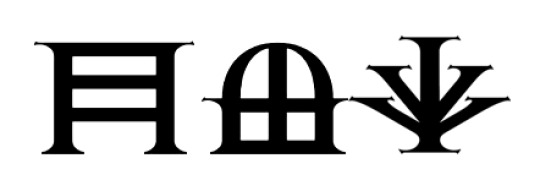
It’s also important to note there are Ghiscari words borrowed into the Valyrian language ( according to the conlang creator ). One of these words, for example, is ‘jazdan’ which means ‘harpy’. This of course, makes sense, given the fact that Old Ghis predated Valyria.
This all being said for now, I will be updating the section the more I research/learn and/or are given more info in the show from the conlang creator. Remember this is always a work in progress.
#i am happy with this it came out good enough and simple enough in explanation i think#i didnt go full on into the grammar part cuz... yeah it's not even completed that we know of so xD but it's a general thing#it's enough to serve as reference for RP purposes which is why I do these headcanons#if you read it all THANK YOU OK cuz i know it long and it could've been longer xD i had to edit myself to keep it focused#[ L E N T O N ] Valyria#[ D R A G O N L O R D ] Vaedar#vae headcanons#headcanons
29 notes
·
View notes
Text
Content note for discussions of eternal damnation, and all sorts of other shit that will trigger a lot of folks with religious trauma.
Before I get started I might as well explain where I’m coming from - unlike a lot of She-Ra fans, and a lot of queer people, I don’t have much religious trauma, or any, maybe (okay there were a number of years I was convinced I was going to hell, but that happens to everyone, right?). I was raised a liberal Christian by liberal Christian parents in the Episcopal Church, where most of my memories are overwhelmingly positive. Fuck, growing up in the 90’s, Chuch was probably the only place outside my home I didn’t have homophobia spewed at me. Because it was the 90’s and it was a fucking hellscape of bigotry where 5 year olds knew enough to taunt each other with homophobic slurs and the adults didn’t know enough to realize how fucked up that was. Anyway. This is my experience, but it is an atypical one, and I know it. Quite frankly I know that my experience of Christianity has very little at all to do with what most people experienced, or what people generally mean when they talk about Christianity as a cultural force in America today. So if you were raised Christian and you don’t recognize your theology here, congrats, neither do I, but these ideas and cultural forces are huge and powerful and dominant. And it’s this dominant Christian narrative that I’m referring to in this post. As well as, you know, a children’s cartoon about lesbian rainbow princesses. So here it goes. This is going to get batshit.
"All events whatsoever are governed by the secret counsel of God." - John Calvin
“We’re all just a bunch of wooly guys” - Noelle Stevenson
This is a post triggered by a single scene, and a single line. It’s one of the most fucked-up scenes in She-Ra, toward the end of Save the Cat. Catra, turned into a puppet by Prime, struggles with her chip, desperately trying to gain control of herself, so lost and scared and vulnerable that she flings aside her own death wish and her pride and tearfully begs Adora to rescue her. Adora reaches out , about to grab her, and then Prime takes control back, pronounces ‘disappointing’ and activates the kill switch that pitches Catra off the platform and to her death (and seriously, she dies here, guys - also Adora breaks both her legs in the fall). But before he does, he dismisses Catra with one of his most chilling lines. “Some creatures are meant only for destruction.”
And that’s when everyone watching probably had their heart broken a little bit, but some of the viewers raised in or around Christianity watching the same scene probably whispered ‘holy shit’ to themselves. Because Prime’s line - which works as a chilling and callous dismissal of Catra - is also an allusion to a passage from the Bible. In fact, it’s from one of the most fucked up passages in a book with more than its share of fucked up passages. It’s from Romans 9:22, and I’m going to quote several previous verses to give the context of the passage (if not the entire Epistle, which is more about who needs to abide by Jewish dietary restrictions but was used to construct a systematic theology in the centuries afterwards because people decided it was Eternal Truth).
19 Thou wilt say then unto me, Why doth he yet find fault? For who hath resisted his will?
20 Nay but, O man, who art thou that repliest against God? Shall the thing formed say to him that formed it, Why hast thou made me thus?
21 Hath not the potter power over the clay, of the same lump to make one vessel unto honour, and another unto dishonour?
22 What if God, willing to shew his wrath, and to make his power known, endured with much longsuffering the vessels of wrath fitted to destruction:
The context of the allusion supports the context in the show. Prime is dismissing Catra - serial betrayer, liar, failed conqueror, former bloody-handed warlord - as worthless, as having always been worthless and fit only to be destroyed. He is speaking from a divine and authoritative perspective (because he really does think he’s God, more of this in my TL/DR Horde Prime thing). Prime is echoing not only his own haughty dismissal of Catra, and Shadow Weaver’s view of her, but also perhaps the viewer’s harshest assessment of her, and her own worst fears about herself. Catra was bad from the start, doomed to destroy and to be destroyed. A malformed pot, cracked in firing, destined to be shattered against a wall and have her shards classified by some future archaeologist 2,000 years later. And all that’s bad enough.
But the full historical and theological context of this passage shows the real depth of Noelle Stevenson’s passion and thought and care when writing this show. Noelle was raised in Evangelical or Fundamentalist Christianity. To my knowledge, he has never specified what sect or denomination, but in interviews and her memoir Noelle has shown a particular concern for questions that this passage raises, and a particular loathing for the strains of Protestant theology that take this passage and run with it - that is to say, Calvinism. So while I’m not sure if Noelle was raised as a conservative, Calvinist Presbyterian, his preoccupation with these questions mean that it’s time to talk about Calvinism.
It would be unfair, perhaps, to say that Calvinism is a systematic theology built entirely upon the Epistles of Romans and Galatians, but only -just- (and here my Catholic readers in particular will chuckle to themselves and lovingly stroke their favorite passage of the Epistle of James). The core of Calvinist Doctrine is often expressed by the very Dutch acronym TULIP:
Total Depravity - people are wholly evil, and incapable of good action or even willing good thoughts or deeds
Unconditional Election - God chooses some people to save because ¯\_(ツ)_/¯, not because they did anything to deserve, trigger or accept it
Limited Atonement - Jesus died only to save the people God chose to save, not the rest of us bastards
Irresistible Grace - God chooses some people to be saved - if you didn’t want to be saved, too bad, God said so.
Perseverance of the Saints - People often forget this one and assume it’s ‘predestination’ but it’s actually this - basically, once saved by God, always saved, and if it looks like someone falls out of grace, they were never saved to begin with. Well that’s all sealed up tight I guess.
Reading through these, predestination isn’t a single doctrine in Calvinism but the entire theological underpinnings of it together with humanity’s utter powerlessness before sin. Basically God has all agency, humanity has none. Calvinism (and a lot of early modern Protestantism) is obsessed with questions of how God saves people (grace alone, AKA Sola Fides) and who God saves (the people god elects and only the people God elects, and fuck everyone else).
It’s apparent that Noelle was really taken by these questions, and repelled by the answers he heard. He’s alluded to having a tattoo refuting the Gospel passage about Sheep and Goats being sorted at the end times, affirming instead that ‘we’re all just a bunch of wooly guys’ (you can see this goat tattoo in some of his self-portraits in comics, etc). He’s also mentioned that rejecting and subverting destiny is a huge part of everything he writes as a particular rejection of the idea that some individual people are 'chosen' by God or that God has a plan for any of us. You can see that -so clearly- in Adora’s arc, where Adora embraces and then rejects destiny time and again and finally learns to live life for herself.
But for Catra, we’re much more concerned about the most negative aspect of this - the idea that some people are vessels meant for destruction. And that’s something else that Noelle is preoccupied with. In her memoir in the section about leaving the church and becoming a humanistic atheist, there is a drawing of a pot and the question ‘Am I a vessel prepared for destruction?’ Obviously this was on Noelle’s mind (And this is before he came out to himself as queer!).
To look at how this question plays out in Catra’s entire arc, let’s first talk about how ideas of damnation and salvation actually play out in society. And for that I’m going to plug one of my favorite books, Gin Lun’s Damned Nation: Hell in America from the Revolution to Reconstruction (if you can tell by now, I am a fucking blast at parties). Lun tells the long and very interesting story about, how ideas of hell and who went there changed during the Early American Republic. One of the interesting developments that she talks about is how while at first people who were repelled by Calvinism started moving toward a doctrine of universal salvation (no on goes to hell, at least not forever*), eventually they decided that hell was fine as long as only the right kind of people went there. Mostly The Other - non-Christian foreigners, Catholics, Atheists, people who were sinners in ways that were not just bad but weird and violated Victorian ideas of respectability. Really, Hell became a way of othering people, and arguably that’s how it survives today, especially as a way to other queer people (but expanding this is slated for my Montero rant). Now while a lot of people were consciously rejecting Calvinist predestination, they were still drawing the distinction between the Elect (good, saved, worthwhile) and the everyone else (bad, damned, worthless). I would argue that secularized ideas of this survive to this day even among non-Christian spaces in our society - we like to draw lines between those who Elect, and those who aren’t.
And that’s what brings us back to Catra. Because Catra’s entire arc is a refutation of the idea that some people are worthless and irredeemable, either by nature, nurture or their own actions. Catra’s actions strain the conventions of who is sympathetic in a Kid’s cartoon - I’ve half joked that she’s Walter White as a cat girl, and it’s only half a joke. She’s cruel, self-deluded, she spends 4 seasons refusing to take responsibility for anything she does and until Season 5 she just about always chooses the thing that does the most damage to herself and others. As I mentioned in my Catra rant, the show goes out of its way to demonstrate that Catra is morally culpable in every step of her descent into evil (except maybe her break with reality just before she pulls the lever). The way that Catra personally betrays everyone around her, the way she strips herself of all of her better qualities and most of what makes her human, hell even her costume changes would signal in any other show that she’s irredeemable.
It’s tempting to see this as Noelle’s version of being edgy - pushing the boundaries of what a sympathetic character is, throwing out antiheroics in favor of just making the villain a protagonist. Noelle isn’t quite Alex ‘I am in the business of traumatizing children’ Hirsch, who seems to have viewed his job as pushing the bounds of what you could show on the Disney Channel (I saw Gravity Falls as an adult and a bunch of that shit lives rent free in my nightmares forever), but Noelle has his own dark side, mostly thematically. The show’s willingness to deal with abuse, and messed up religious themes, and volatile, passionate, not particularly healthy relationships feels pretty daring. I’m not joking when I gleefully recommend this show to friends as ‘a couple from a Mountain Goats Song fights for four seasons in a cartoon intended for 9 year olds’. Noelle is in his own way pushing the boundaries of what a kids show can do. If you read Noelle’s other works like Nimona, you see an argument for Noelle being at least a bit edgy. Nimona is also angry, gleefully destructive, violent and spiteful - not unlike Catra. Given that it was a 2010s webcomic and not a kids show, Nimona is a good deal worse than Catra in some ways - Catra doesn’t kill people on screen, while Nimona laughs about it (that was just like, a webcomic thing - one of the fan favorite characters in my personal favorite, Narbonic, was a fucking sociopath, and the heroes were all amoral mad scientists, except for the superintelligent gerbil**). But unlike Nimona, whose fate is left open ended, Catra is redeemed.
And that is weird. We’ve had redemption arcs, but generally not of characters with -so- much vile stuff in their history. Going back to the comparison between her and Azula, many other shows, like Avatar, would have made Catra a semi-sympathetic villain who has a sob-story in their origin but who is beyond redemption, and in so doing would articulate a kind of psychologized Calvinism where some people are too traumatized to ever be fully and truly human. I’d argue this is the problem with Azula as a character - she’s a fun villain, but she doesn’t have moral agency, and the ultimate message of her arc - that she’s a broken person destined only to hurt people - is actually pretty fucked up. And that’s the origin story of so many serial killers and psycopaths that populate so many TV shows and movies. Beyond ‘hurt people hurt people’ they have nothing to teach us except perhaps that trauma makes you a monster and that the only possible response to people doing bad things is to cut them out of your life and out of our society (and that’s why we have prisons, right?)
And so Catra’s redemption and the depths from which she claws herself back goes back to Noelle’s desire to prove that no person is a vessel ‘fitted for destruction.’ Catra goes about as far down the path of evil as we’ve ever seen a protagonist in a kids show go, and she still has the capacity for good. Importantly, she is not subject to total depravity - she is capable of a good act, if only one at first. Catra is the one who begins her own redemption (unlike in Calvinism, where grace is unearned and even unwelcomed) - because she wants something better than what she has, even if its too late, because she realizes that she never wanted any of this anyway, because she wants to do one good thing once in her life even if it kills her.
The very extremity of Catra’s descent into villainy serves to underline the point that Noelle is trying to make - that no one can be written off completely, that everyone is capable of change, and that no human being is garbage, no matter how twisted they’ve become. Meanwhile her ability to set her own redemption in motion is a powerful statement of human agency, and healing, and a refutation of Calvinism’s idea that we are powerless before sin or pop cultural tropes about us being powerful before the traumas of our upbringing. Catra’s arc, then, is a kind of anti-Calvinist theological statement - about the nature of people and the nature of goodness.
Now, there is a darker side to this that Noelle has only hinted at, but which is suggested by other characters on the show. Because while Catra’s redemption shows that people are capable of change, even when they’ve done horrible things, been fucked up and fucked themselves up, it also illustrates the things people do to themselves that make change hard. As I mentioned in my Catra rant, two of the most sinister parts of her descent into villainy are her self-dehumanization (crushing her own compassion and desire to do good) and her rewriting of her own history in her speech and memory to make her own actions seem justified (which we see with her insistence that Adora left her, eliding Adora’s offers to have Catra join her, or her even more clearly false insistence that Entrapta had betrayed them). In Catra, these processes keep her going down the path of evil, and allow her to nearly destroy herself and everyone else. But we can see the same processes at work in two much darker figures - Shadow Weaver and Horde Prime. These are both rants for another day, but the completeness of Shadow Weaver’s narcissistic self-justification and cultivated callousness and the even more complete narcissism of Prime’s god complex cut both characters off from everyone around them. Perhaps, in a theoretical sense, they are still redeemable, but for narrative purposes they might as well be damned.
This willingness to show a case where someone -isn’t- redeemed actually serves to make Catra’s redemption more believable, especially since Noelle and the writers draw the distinction between how Catra and SW/Prime can relate to reality and other people, not how broken they are by their trauma (unlike Zuko and Azula, who are differentiated by How Fucked Uolp They Are). Redemption is there, it’s an option, we can always do what is right, but someone people will choose not to, in part because doing the right thing involves opening ourselves to the world and others, and thus being vulnerable. Noelle mentions this offhandedly in an interview after Season 1 with the She-Ra Progressive of Power podcast - “I sometimes think that shades of grey, sympathetic villains are part of the escapist fantasy of shows like this.” Because in the real world, some people are just bastards, a point that was particularly clear in 2017. Prime and Shadow Weaver admit this reality, while Catra makes a philosophical point that even the bastards can change their ways (at least in theory).
*An idea first proposed in the second century by Origen, who’s a trip and a fucking half by himself, and an idea that becomes the Catholic doctrine of purgatory, which protestants vehemently denied!
**Speaking of favorite Noelle tropes
248 notes
·
View notes
Text
The Two (or more) Ishtars or A Certain Scandalous Easter Claim Proved to be The Worship of Reverend Alexander Hislop

Once upon a time the official facebook page of Richard Dawkins' foundation posted a graphic according to which the holiday of Easter is just a rebranded celebration of the Mesopotamian mythology superstar Ishtar, arguing that the evidence is contained in its very name. As everyone knows, Dawkins is an online talking head notable for discussing his non-belief in such an euphoric way that it might turn off even the most staunch secularists and for appearing in some reasonably funny memes about half a decade ago. Bizarrely enough, however, the same claim can be often found among the crowds dedicated to crystal healing, Robert Graves' mythology fanfiction, indigo children and similar dubiously esoteric content. What's yet more surprising is that once in a while it shows up among a certain subset of fundamentalist Christians, chiefly the types who believe giants are real (and, of course, satanic), the world is ruled by a secret group of Moloch worshipers and fossils were planted by the devil to led the sheeple astray from the truth about earth being 6000 years old, tops. Of course, to anyone even just vaguely familiar with Christianity whose primary language isn't English this claim rightfully seems completely baffling – after all it's evident in most languages that the name of the holiday celebrating Jesus' resurrection, and many associated customs, are derived from the earlier Jewish Pascha (Passover) which has nothing to do with Ishtar other than having its origin in the Middle East. Why would the purported association only be evident in English and not in Aramaic, Greek, Latin, Spanish, virtually any language other than English and its close relatives – languages which generally didn't have anything to do with Mesopotamia or early christianity? Read on to find out what sort of sources let this eclectic selection of characters arrive to the same baffling conclusion, why are they hilariously wrong, and – most importantly – where you can actually find a variety of Ishtars (or at least reasonably Ishtar-like figures) under different names instead.
The story of baffling Easter claims begins in Scotland in the 19th century. A core activity of theologians in many faiths through history was (and sometimes still is) finding alleged proof of purported “idolatry” or other “impure” practices among ideological opponents, even these from within the same religion – and a certain Presbyterian minister, Alexander Hislop, was no stranger to this traditional pastime. Like many Protestants in this period, he had an axe to grind with the catholic church - though not for the reasons many people are not particularly fond of this institution nowadays. What Hislop wanted to prove was much more esoteric – he believed that it's the Babylon known from the Book of Revelations. Complete with the beast with seven heads, blasphemous names and other such paraphernalia, of course. This wasn't a new claim – catholicism was equated with the New Testament Babylon for as long as Protestantism was a thing (and earlier catholicism itself regarded other religions as representing it). What set Hislop apart from dozens of other similar attempts like that was that he fancied himself a scholar of history and relied on the brand new accounts of excavations in what was once the core sphere of influence of the Assyrian empire (present day Iraq and Syria), supplemented by various Greek and Roman classics – though also by his own ideas, generally varying from baseless to completely unhinged. Hislop compiled his claims in the book The Two Babylons or The Papal Worship Proved to be the Worship of Nimrod and His Wife. You can find it on archive.org if you want to torment yourself and read the entire thing – please do not give clicks directly to any fundie sites hosting it though. How does the history of Easter and Ishtar look like according to Hislop? Everything started with Semiramis, who according to his vision was a historical figure and a contemporary of Noah's sons, here also entirely historical. Semiramis is either entirely fictional or a distorted Greek and Roman account of the 9th century BC Assyrian queen Shammuramat, who ruled as a regent for a few years after the death of her husband Shamshi Adad V – an interesting piece of historical trivia, but arguably not really a historical milestone, and by the standards of Mesopotamian history she's hardly a truly ancient figure. Hislop didn't even rely on the primary sources dealing with the legend of Semiramis though, but with their medieval christian interpretations, which cast her in the role of an adulterer first and foremost due to association of ancient Mesopotamia with any and all vices.
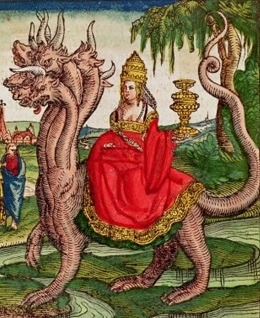
Hislop claims that Semiramis was both the Whore of Babylon from the Book of Revelations and the first idolater, instituting worship of herself as a goddess. This goddess, he argues, was Astarte (a combination of two flimsy claims – Roman claim that Semiramis' name means “dove” and now generally distrusted assumption that Phoenician Astarte had the same symbols as Greek Aphrodite) and thus Ishtar, but he also denotes her as a mother goddess – which goes against everything modern research has to say about Ishtar, of course. However, shoddy scholarship relying on few sources was the norm at the time, and Hislop on top of that was driven by religious zeal. In further passages, he identified this “universal mother” with Phrygian Cybele, Greek Rhea and Athena, Egyptian Isis, Taoist Xi Wangmu (sic) and many more, pretty much at random, arguing all of them were aspects of nefarious Semiramis cult which infected all corners of the globe. He believed that she was venerated alongside a son-consort, derived from Semiramis' even more fictional husband Ninus (a mythical founder of Assyria according to Greek authors, absent from any Mesopotamian sources; his name was derived from Nineveh, not from any word for son like Hislop claims), who he identifies with biblical Nimrod (likewise not a historical figure, probably a distorted reflection of the god Ninurta). Note the similarity with certain ideas perpetrated by Frazer's Golden Bough and his later fans like Jung, Graves and many neopagan authors – pseudohistory, regardless of ideological background, has a very small canon of genuinely original claims. Ishtar was finally introduced to Britain by “druids” (note once again the similarity to the baffling integration of random Greek, Egyptian or Mesopotamian deities into Graves-derived systems of fraudulent trivia about “universal mother goddesses” often using an inaccurate version of Celtic myths as framework). This eventually lead to the creation of the holiday of Easter. Pascha doesn't come up in the book at all, as far as I can tell. All of this is basically just buildup for the book's core shocking reveal: catholic veneration of Mary and depictions of Mary with infant Jesus in particular are actually the worship of Semiramis and her son-consort Ninus, and only the truly faithful can reveal this evil purpose of religious art. At least so claims Hislop. This bizarre idea is laughable, but it remains disturbingly persistent – do you remember the Chick Tracts memes from a few years ago, for example? These comics were in part inspired by Hislop's work. Many fundamentalist christian communities appear to hold his confabulations in high esteem up to this day – and many people who by design see themselves as a countercultural opposition to christianity independently gleefully embrace them, seemingly ignorant of their origin. While there are many articles debunking Hislop's claim about Easter, few of them try to show how truly incomprehensibly bad his book is as a whole – hopefully the following examples will be sufficient to illustrate this point: -Zoroaster is connected to Moloch because of the Zoroastrian holy fire - and Moloch is, of course Ninus. Note that while a few Greek authors believed Zoroaster to be the “king of Bactria” mythical accounts presented as a contemporary of Ninus, the two were regarded as enemies – Hislop doesn't even follow the pseudohistory he uses as proof! -Zoroaster is also Tammuz. Tammuz is, of course, yet another aspect of Ninus. -demonic character is ascribed to relics of the historical Buddha; also he's Osiris. And Ninus. -an incredibly racist passage explains why the biblical Nimrod (identified with – you guessed it - Ninus) might be regarded as “ugly and deformed” like Haephestus and thus identical to him (no, it makes no sense in context either) - Hislop thinks he was black (that's not the word he uses, naturally) which to him is the same thing. -Attis is a deification of sin itself -the pope represents Dagon (incorrectly interpreted as a fish god in the 19th century) -Baal and Bel are two unrelated words – this is meant to justify the historicity of the Tower of Babel by asserting it was built by Ninus, who was identical to Bel (in reality a title of Marduk); Bel, according to Hislop, means “the confounder (of languages)” rather than “lord” -the term “cannibal” comes from a made up term for priests of Baal (Ninus) who according to Hislop ate children. In reality it's a Spanish corruption of the endonym of one of the first tribes encountered by the Spanish conquerors in America, and was not a word used in antiquity – also, as I discussed in my Baal post, the worship of Baal did not involve cannibalism. This specific claim of Hislop's is popular with the adherents of prophetic doomsday cult slash wannabe terrorist group QAnon today, and shows up on their “redpilling” graphics. -Ninus was also Cronos; Cronos' name therefore meant “horned one” in reference to Mesopotamian bull/horned crown iconography and many superficially similar gods from all over the world were the same as him - note the similarity to Margaret Murray's obsession with her made up idea of worldwide worship of a “horned god” (later incorporated into Wicca). -Phaeton, Orpheus and Aesculapius are the same figure and analogous to Lucifer (and in turn to Ninus) -giants are real and they're satanists (or were, I think Hislop argues they're dead already). They are (were?) also servants of Ninus. -as an all around charming individual Hislop made sure to include a plethora of comments decrying the practices of various groups at random as digressions while presenting his ridiculous theories – so, while learning about the forbidden history of Easter, one can also learn why the author thinks Yezidi are satanists, for example -last but not least, the very sign of the cross is not truly christian but constitutes the worship of Tammuz, aka Ninus (slowly losing track of how many figures were regarded as one and the same as him by Hislop). Based on the summary above it's safe to say that Hislop's claim is incorrect – and, arguably, malevolent (and as such deserves scrutiny, not further possibilities for spreading). However, this doesn't answer the question where does the name of Easter actually come from? As I noted in the beginning, in English (and also German) it's a bit of an oddity – it actually was derived from a preexisting pagan term, at least if we are to believe the word of the monk Bede, who in the 8th century wrote that the term is a derivative of “Eosturmonath,” eg. “month of Eostre” - according to him a goddess. There are no known inscriptions mentioning such a goddess from the British Isles or beyond, though researchers involved in reconstructing proto-indo-european language assume that “Eostre” would logically be a derivative of the same term as the name of the Greek Eos and of the vedic Ushas, and the Austriahenae goddesses from Roman inscriptions from present day Germany – eg. a word simply referring to dawn, and by extension to a goddess embodying it. This is a sound, well researched theory, so while early medieval chroniclers sometimes cannot be trusted, I see no reason to doubt Bede's account.
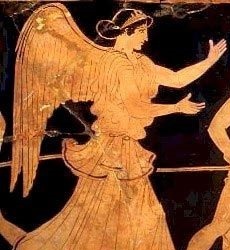
While Ushas is a prominent goddess in the Vedas, Eos was rather marginal in Greek religion (see her Theoi entry for details), and it's hard to tell to what degree Bede's Eostre was similar to either of them beyond plausibly being a personification of dawn. Of course, the hypothetical proto-indo-european dawn goddess all of these could be derived from would have next to nothing to do with Ishtar. While the history of the name of Easter (though not the celebration itself) is undeniably interesting, I suppose it lacks the elements which make the fake Ishtar claim a viral hit – the connection is indirect, and an equivalent of the Greek Eos isn't exactly exciting (Eos herself is, let be honest, remembered at best as an obscure part of the Odyssey), while Ishtar is understood by many as “wicked” sex goddess (a simplification, to put it very lightly) which adds a scandalous, sacrilegious dimension to the baffling lie, explaining its appeal to Dawkins' fans, arguably. As demonstrated above, Hislop's theories are false and adapting them for any new context – be it christian, atheist or neopagan – won't change that, but are there any genuine examples of, well, “hidden Ishtars”? If that's the part of the summary which caught your attention, rejoice – there is a plenty of these to be found in Bronze Age texts. I'd go as far as saying that most of ancient middle eastern cultures from that era felt compelled to include an Ishtar ersatz in their pantheons. Due to the popularity of the original Ishtar, she was almost a class of figures rather than a single figure – a situation almost comparable to modern franchising, when you think about it. The following figures can be undeniably regarded as “Ishtar-like” in some capacity or even as outright analogs:
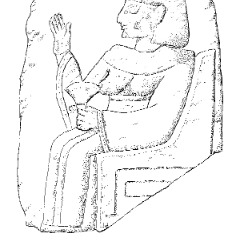
Astarte (or Ashtart, to go with a more accurate transcription of the oldest recorded version of the name) – the most direct counterpart of Ishtar there is: a cognate of her own name. Simply, put Astarte is the “Levantine”equivalent of the “Mesopotamian” Ishtar. In the city of Mari, the names were pretty much used interchangeably, and some god lists equate them, though Astarte had a fair share of distinct traits. In Ugaritic mythology, which forms the core of our understanding of the western Semitic deities, she was a warrior and hunter (though it's possible that in addition to conventional weapons she was also skilled at wielding curses), and was usually grouped with Anat. Both of them were regarded as the allies of Baal, and assist him against his enemies in various myth. They also were envisioned to spend a lot of time together – one ritual calls them upon as a pair from distant lands where they're hunting together, while a fragmentary myth depicts both of them arriving in the household of the head god El and taking pity on Yarikh, the moon god, seemingly treated as a pariah. Astarte's close relation to Baal is illustrated by her epithet, “face of Baal” or “of the name of Baal.” They were often regarde as a couple and even late, Hellenic sources preserve a traditional belief that Astarte and “Adados” (Baal) ruled together as a pair. In some documents from Ugarit concerned with what we would call foreign policy today they were invoked together as the most prominent deities. It's therefore possible that she had some role related to human politics. She was regarded as exceptionally beautiful and some texts favorably describe mortal women's appearance by comparing them to Astarte. In later times she was regarded as a goddess of love, but it's unclear if that was a significant aspect of her in the Bronze Age. It's equally unclear if she shared Ishtar's astral character – in Canaan there were seemingly entirely separate dawn and dusk deities. Despite clamis you might see online, Astarte was not the same as the mother goddess Asherah. In the Baal cycle they actually belong to the opposing camps. Additionally, the names are only superficially similar (one starts with an aleph, the other with an ayin) and have different etymology. Also, that famous sculpture of a very blatantly Minoan potnia theron? Ugaritic in origin but not a depiction of either Astarte or Asherah.
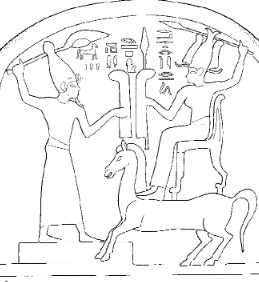
The Egyptians, due to extensive contact with Canaan and various Syrian states in the second half of the Bronze Age, adapted Astarte (and by extension Anat) into their own pantheon. Like in Ugarit, her warrior character was emphasized. An Egyptian innovation was depicting her as a cavalry goddess of sorts – associated with mounted combat and chariots. In Egypt, Ptah, the head god of Memphis and divine craftsman, was regarded as her father. In most texts, Astarte is part of Seth's inner circle of associates – however, in this context Seth wasn't the slayer of Osiris, but a heroic storm god similar to Baal. The so-called Astarte papyrus presents an account of a myth eerily similar to the Ugaritic battle between Baal and Yam – starring Seth as the hero, with Astarte in a supporting role resembling that played by Shaushka, another Ishtar analog, in the Hittite song of Hedammu, which will be discussed below.
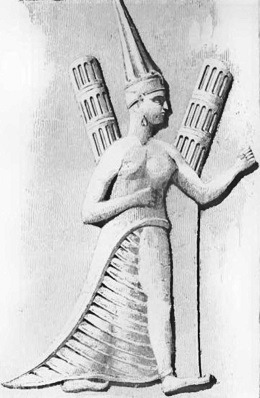
Shaushka – a Hurrian and Hittite goddess whose name means “the magnificent one” in the Hurrian language. Hurrian was widely spoken in ancient Mesopotamia and Anatolia (and in northernmost parts of the Levant – up to one fifth of personal names from Ugaritic documents were Hurrian iirc), but has no descendants today and its relation to any extant languages is uncertain. In Hittite texts she was often referred to with an “akkadogram” denoting Ishtar's name (or its Sumerian equivalent) instead of a phonetic spelling of her own (there was an analogous practice regarding the sun gods), while in Egyptian and Syrian texts there are a few references to “Ishtar Hurri” - “Ishtar of the Hurrians” - who is argued by researchers to be one and the same as Shaushka. Despite Shaushka's Hurrian name and her prominence in myths popular both among Hittites and Hurrians, her main cult center was the Assyrian city of Nineveh, associated with Ishtar herself as well, and there were relatively few temples dedicated to her in the core Hittite sphere of influence in Anatolia. Curiously, both the oldest reference to Shaushka and to the city of Nineveh come from the same text, stating that a sheep was sacrificed to her there. While most of her roles overlap with Ishtar's (she too was associated with sex, warfare and fertility), here are two distinct features of Shaushka that set her apart as unique: one is the fact she was perceived in part as a masculine deity, despite being consistently described as a woman – in the famous Yazılıkaya reliefs she appears twice, both among gods and goddesses. In Alalakh she was depicted in outfits combining elements of male and female clothing. Similar fashion preferences were at times attributed to Ninshubur, the attendant of Ishtar's Sumerian forerunner Inanna – though in that case they were likely the result of conflation of Ninshubur with the male messenger deity Papsukkal, while in the case of Shaushka the dual nature seems to be inherent to her (I haven't seen any in depth study of this matter yet, sadly, so I can't really tell confidently which modern term in my opinion describes Shaushka's character the best). Her two attendants, musician goddesses Ninatta and Kulitta, do not share it. Shaushka's other unique niche is her role in exorcisms and incantations, and by extension with curing various diseases – this role outlived her cult itself, as late Assyrian inscriptions still associated the “Ishtar of Nineveh” (at times viewed as separate from the regular Ishtar) with healing. It can be argued that even her sexual aspect was connected to healing, as she was invoked to cure impotence. The most significant myth in which she appears is the cycle dedicated to documenting the storm god's (Teshub for the Hurrians, Tarhunna for the Hittites) rise to power. Shaushka is depicted as his sister and arguably most reliable ally, and plays a prominent role in two sections in particular – the Song of Hedammu and the Song of Ullikummi. In the former, she seemingly comes up with an elaborate plan to defeat a new enemy of her brother - the sea monster Hedammu - by performing a seductive dance and song montage (with her attendants as a support act) and offering an elixir to him. The exact result is uncertain, but Hedammu evidently ends up vanquished. In the latter, she attempts to use the same gambit against yet another new foe, the “diorite man” Ullikummi – however, since he is unfeeling like a rock, she fails; some translators see this passage as comedic. However, elsewhere in the Song, the storm god's main enemy Kumarbi and his minions view Shaushka as a formidable warrior, and in the early installment of the cycle, Song of LAMMA, she seemingly partakes in a fight. In another myth, known only from a few fragments and compared to the Sumerian text “Inanna and the huluppu tree,” Shaushka takes care of “Ḫašarri” - a personification of olive oil, or a sentient olive tree. It seems that she has to protect this bizarre entity from various threats. While Shaushka lived on in Mesopotamia as “Ishtar of Nineveh,” this was far from the only “variant”of Ishtar in her homeland.
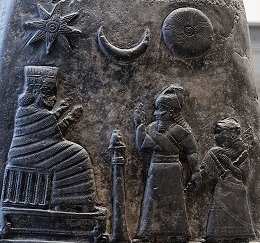
Nanaya was another such goddess. A few Sumerian hymns mention her alongside Inanna, the Sumerian equivalent of Ishtar, by the time of Sargon of Akkad virtually impossible to separate from her. As one composition puts it, Nanaya was “properly educated by holy Inana” and “counselled by holy Inana.” Initially she was most likely a part of Inanna's circle of deities in her cult center, Uruk, though due to shared character they eventually blurred together to a large degree. Just like Inanna/Ishtar, Nanaya was a goddess of love, described as beautiful and romantically and sexually active, and she too had an astral character. She was even celebrated during the same holidays as Inanna. Some researchers go as far as suggest Nanaya was only ever Inanna/Ishtar in her astral aspect alone and not a separate goddess. However, there is also evidence of her, Inanna and the sky god An being regarded as a trinity of distinct tutelary deities in Uruk. Additionally, king Melishipak's kudurru shown above shows both Nanaya (seated) and Ishtar/Inanna (as a star). Something peculiar to Nanaya was her later association with the scribe god Nabu. Sometimes Nabu's consort was the the goddess Tashmetu instead, but I can't find any summary explaining potential differences between them – it seems just like Nanaya, she was a goddess of love, including its physical aspects. Regardless of the name used to describe Nabu's wife, she was regarded as a sage and scribe like him – this arguably gives her a distinct identity she lacked in her early role as part of Inanna's circle. As the above examples demonstrate, the popularity of the “Ishtar type” was exceptional in the Bronze Age – but is it odd from a modern perspective? The myths dedicated to her are still quite fun to read today – much like any hero of ancient imagination she has a plethora of adversaries, a complex love life (not to mention many figures not intended to be read as her lovers originally but described in such terms that it's easy to see them this way today – including other women), a penchant for reckless behavior – and most importantly a consistent, easy to summarize character. She shouldn't be a part of modern mass consciousness only because of false 19th century claims detached from her actual character (both these from Hislop's works and “secular”claims about her purported “real”character based on flimsy reasoning and shoddy sources) – isn't a female character who is allowed to act about the same way as male mythical figures do without being condemned for it pretty much what many modern mythology retellings try to create? Further reading: On Astarte: -entry in the Iconography of Deities and Demons in Ancient Near East database by Izak Cornelius -‛Athtart in Late Bronze Age Syrian Texts by Mark S. Smith -ʿAthtartu’s Incantations and the Use of Divine Names as Weapons by Theodore J. Lewis -The Other Version of the Story of the Storm-god’s Combat with the Sea in the Light of Egyptian, Ugaritic, and Hurro-Hittite Texts by Noga Ayali-Darshan -for a summary of evidence that Astarte has nothing to do with Asherah see A Reassessment of Asherah With Further Considerations of the Goddess by Steve A. Wiggins On Shaushka: -Adapting Mesopotamian Myth in Hurro-Hittite Rituals at Hattuša: IŠTAR, the Underworld, and the Legendary Kings by Mary R. Bacharova -Ishtar seduces the Sea-serpent. A new join in the epic of Ḫedammu (KUB 36, 56 + 95) and its meaning for the battle between Baal and Yam in Ugaritic tradition by Meindert Dijkstra -Ištar of Nineveh Reconsidered by Gary Beckman -Shaushka, the Traveling Goddess by Graciela Gestoso Singer -Hittite Myths by Harry A. Hoffner jr. -The Hurritic Myth about Šaušga of Nineveh and Ḫašarri (CTH 776.2) by Meindert Dijkstra -The West Hurian Pantheon and its Background by Alfonso Archi On Nanaya: -entry in Brill’s New Pauly by Thomas Richter -entry from the Ancient Mesopotamian Gods and Goddesses project by Ruth Horry -A tigi to Nanaya for Ishbi-Erra from The Electronic Text Corpus of Sumerian Literature -A balbale to Inana as Nanaya from The Electronic Text Corpus of Sumerian Literature -More Light on Nanaya by Michael P. Streck and Nathan Wasserman -More on the Nature and History of the Goddess Nanaya by Piotr Steinkeller A few introductory Ishtar/Inanna myths: -Inanna's descent to the netherworld -Inanna and the huluppu tree -Inanna and Enki -Enki and the world order -Inanna and Ebih -Dumuzid and Enkimdu
101 notes
·
View notes